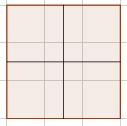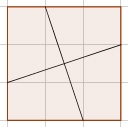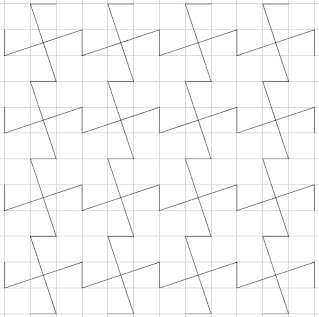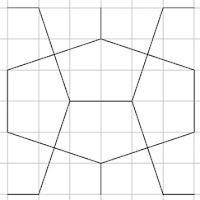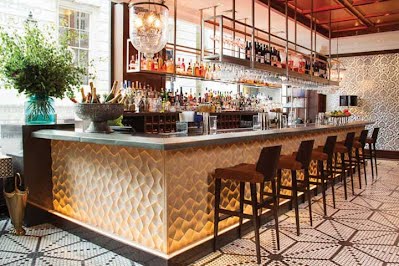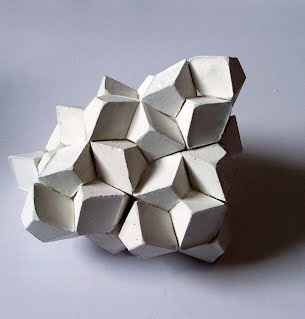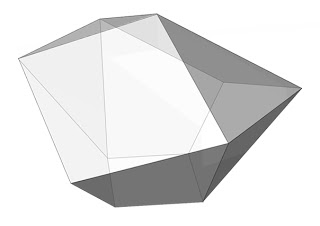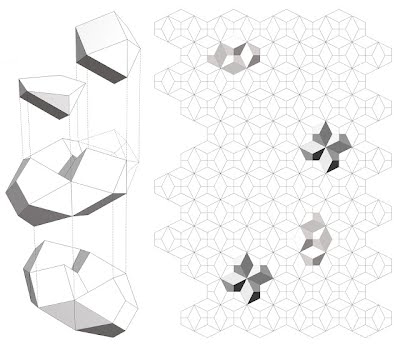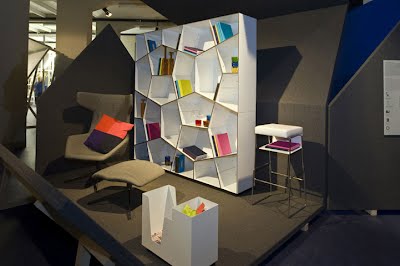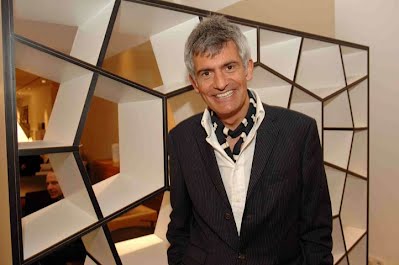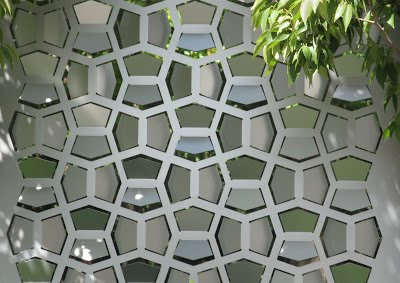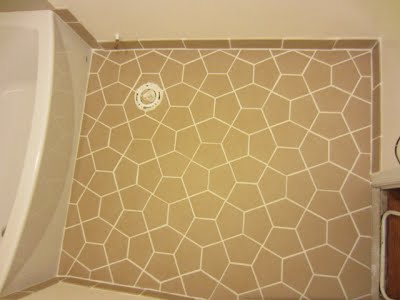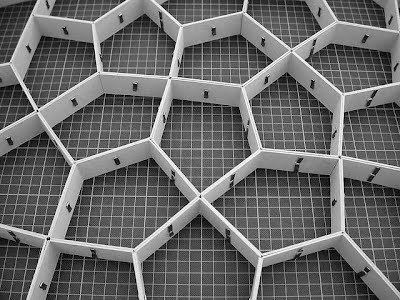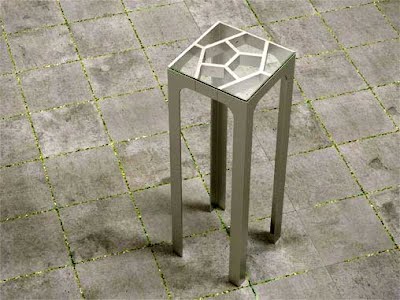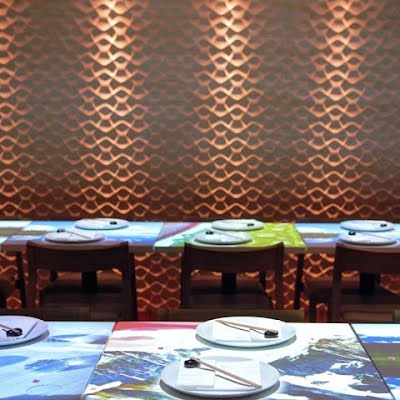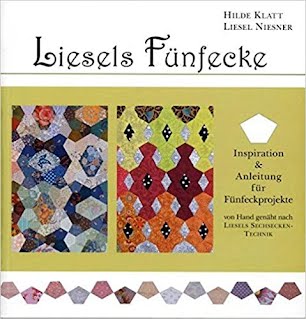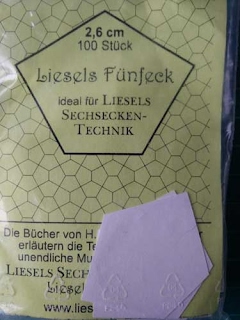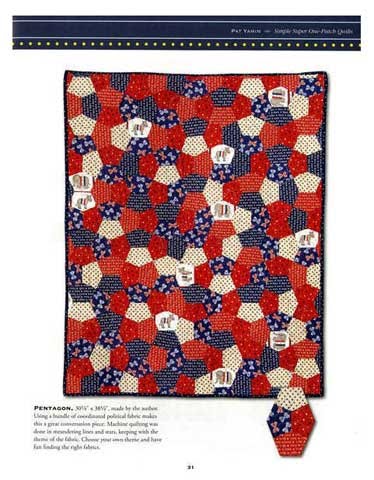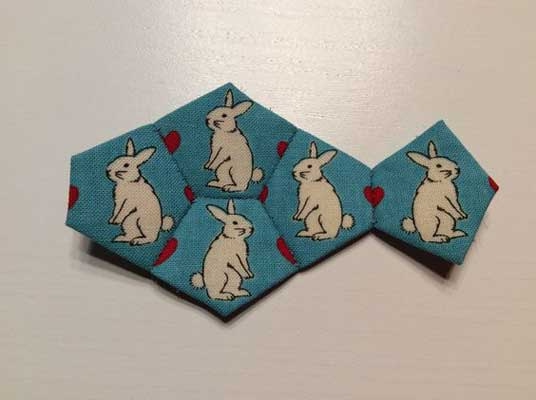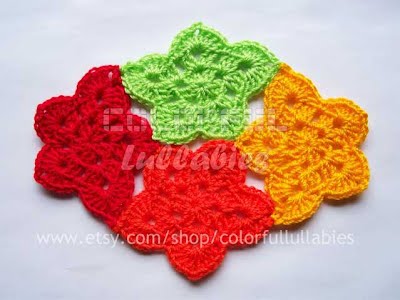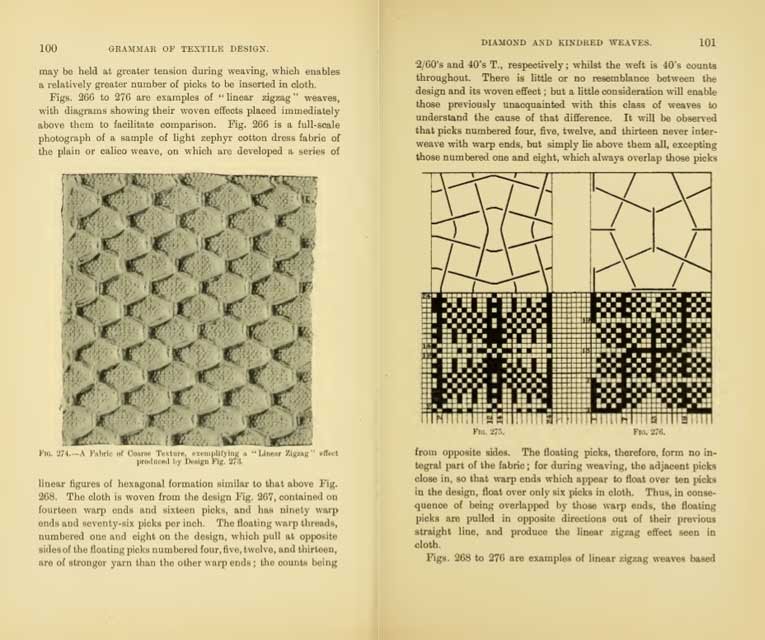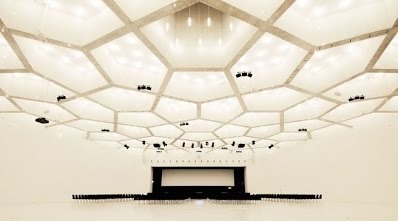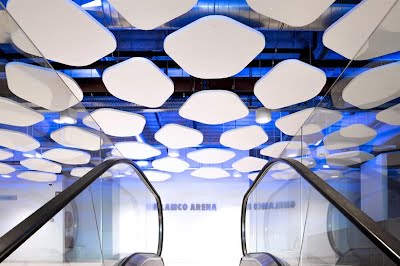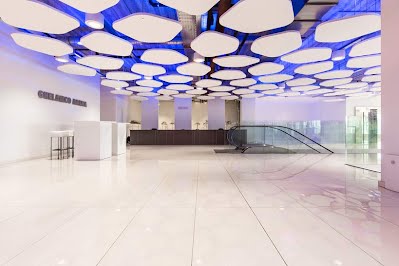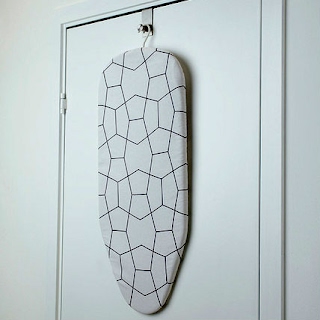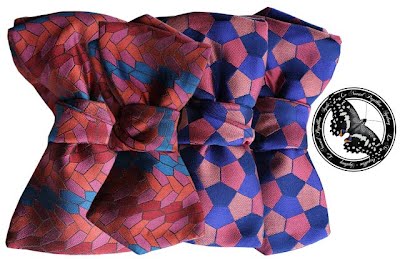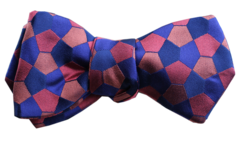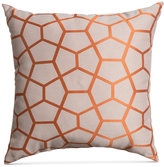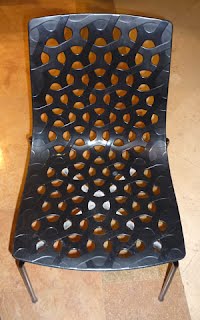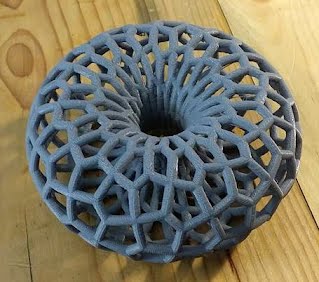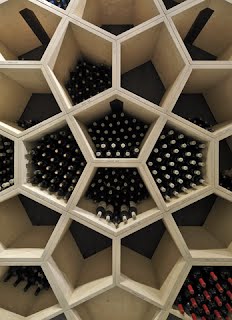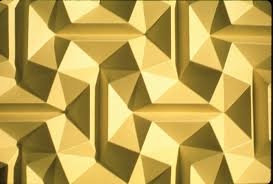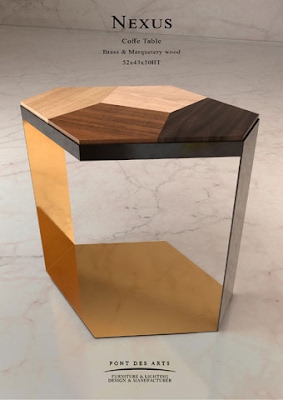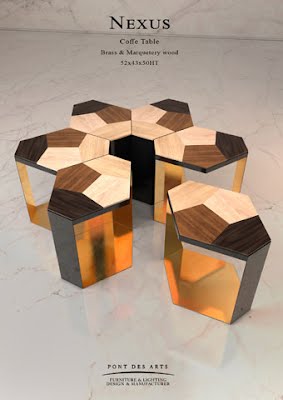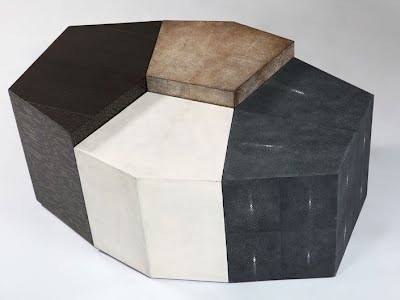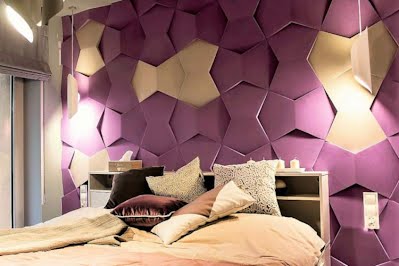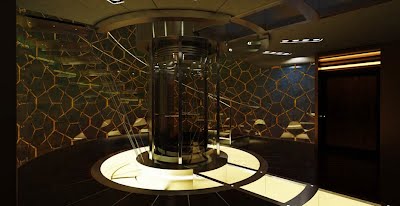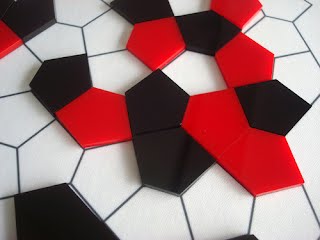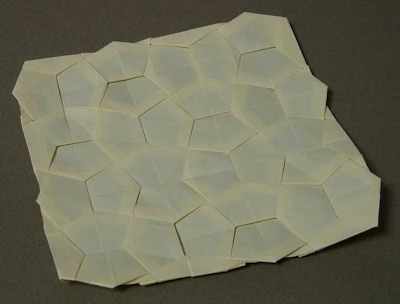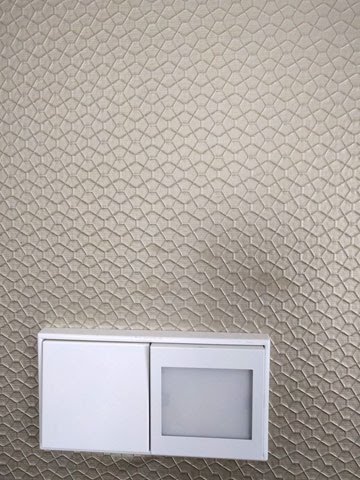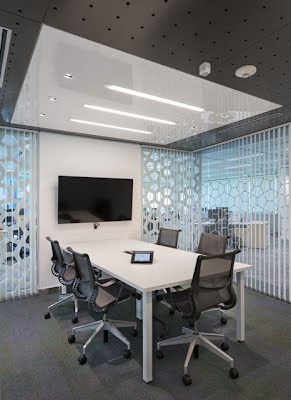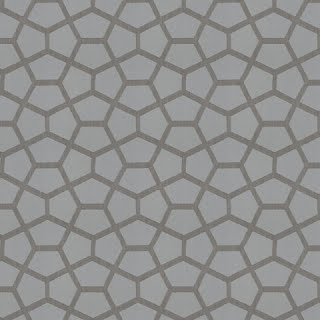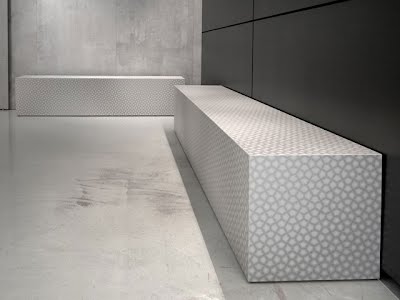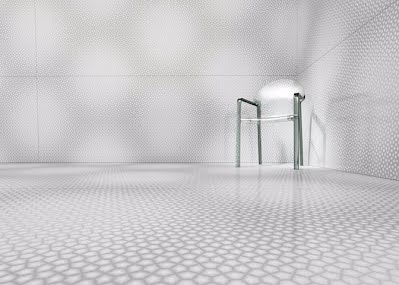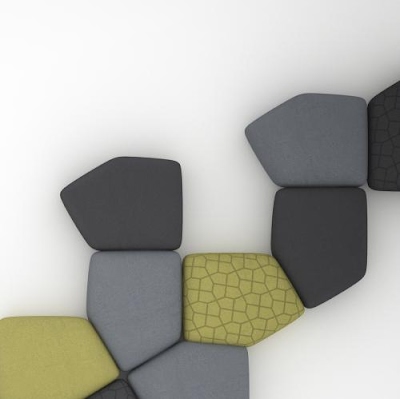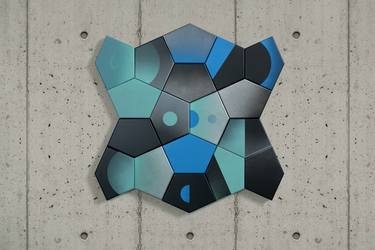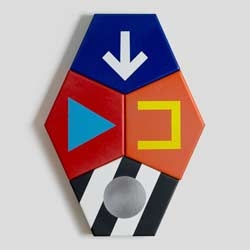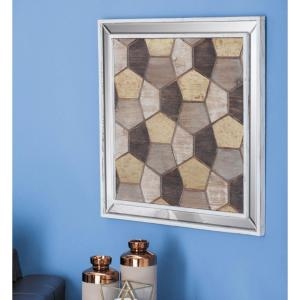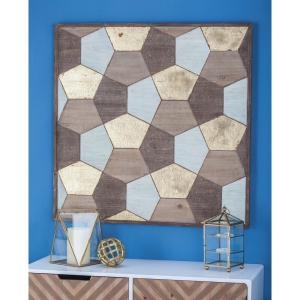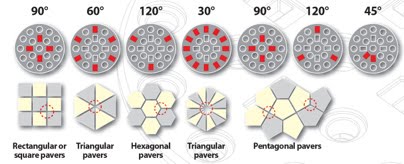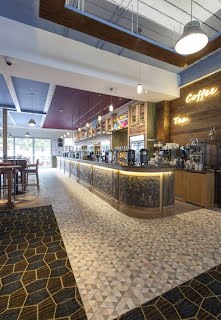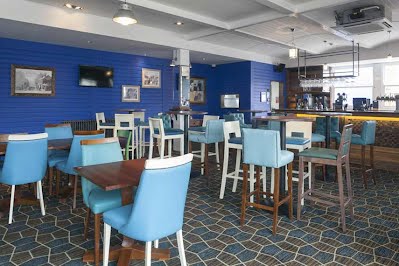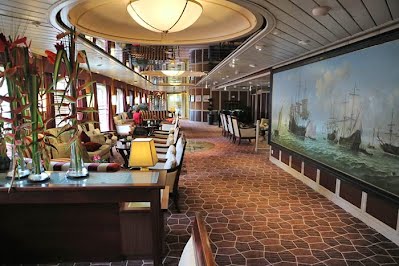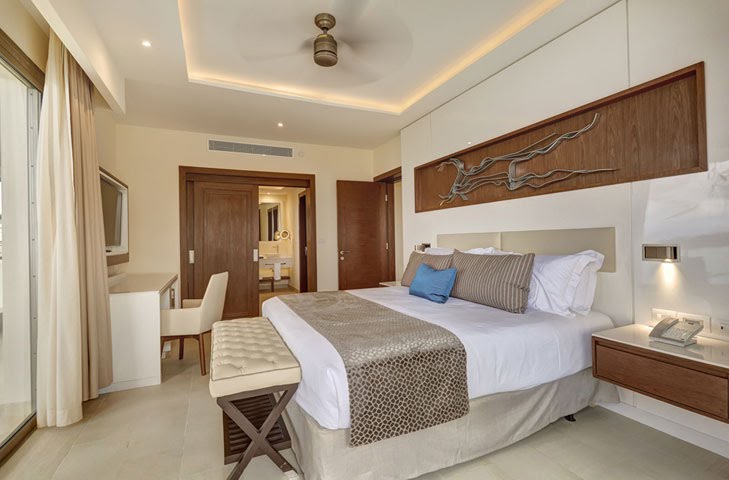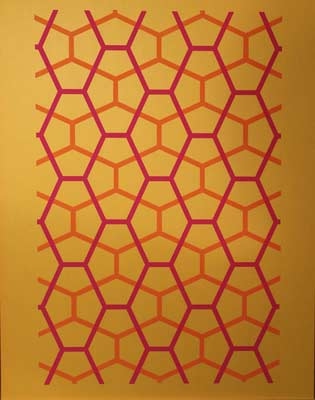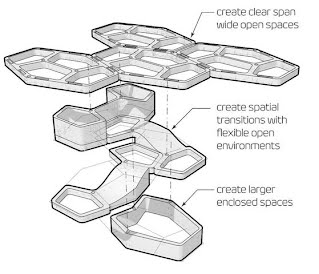Some Thoughts on Designing the Cairo Tile in Ancient History Although a redundant statement, the Cairo tiling is but one of many tilings, both as artefacts and mathematical abstractions, simple and complex, and everything in between. It is interesting to speculate how it originally (of course without the attribution) it may have been found in ancient times, from the very beginning of tiling, about 5,000 years ago, although there is no evidence that this is so. Let us consider the matter of designing tiles/tiling in general, without a thought as to the Cairo tile, and we see how easily and quickly it can arise by a simple experiment, or play.
(i) Of course, we begin in the most simple and basic way, here with a grid of 3 x 3 squares (Fig.1), with an upright cross of equal length. Fig. 1. An upright cross of equal length in side a square (ii) Experiment, with upright crosses of equal length about the midpoint on a square. Translate (or reflect) successively (Fig. 2). This simply gives another square tiling; not very interesting. Fig. 2. Translation of cross (iii) Let's try another idea. Now, retaining the square, instead of having an upright cross, rotate to a natural division (Fig. 3). Fig. 3. Rotating the cross to the next division of the square (iv) Again, translate (Fig. 4). This simply gives an open grid. Fig. 4. Translating the rotated cross(v) An obvious thought is to connect the lines, forming a rotational order 4 tile (Fig. 5). On account of its symmetry, this is thus more interesting, but it is not outstanding or possessing unusual properties in an aesthetic sense. It is but one of many such tilings with order 4 rotational symmetry. Fig. 5. Joining the lines to form an order 4 rotational tile (vi) On the same premise, let’s then try reflecting the rotated cross. This then (naturally) joins up the lines. Reflect successively in two directions, horizontally and vertically. This then gives the 'bowtie' tiling (Fig. 6). This is quite interesting; a symmetrical octagonal tile along two axes, appearing in two orientations, with each line the same length. Fig. 6. Joining the lines to form a bowtie tiling (vii) An obvious thought is then to simply join the two indentations (Fig. 7). Voilà! A Cairo tile is thus formed. It is so basic and easy; even a ten-year-old (if not earlier) child could do this! No mathematical calculation is required. And further, this can be seen to be of the in situ model, with aesthetic features of collinearity and the overlapping of horizontal and vertical parhexagons which is surely an obvious attraction to the mooted designer. Further, it is the first such (Cairo) tiling to appear (as I show elsewhere, it is possible to have different proportions of the tile, in which it degenerates from minima to maxima to a rectangle and a square), in that it is not some arbitrarily high number, such as number 5, or 50, in a long series that is conceivable ‘difficult’ to find; it appears immediately. Indeed, it is entirely feasible to design this even quicker, at the reflecting stick cross stage (vi), without the given mooted beginning sequence. Fig. 7. The composing of a Cairo tile from the 'bowtie' tiling (Viii) Further, from the tiling, it is easy to outline a suitable region in a square to repeat as an actual square tile (Fig. 8). Although it may be stating the obvious, by far the most common shape for a tile is a square, and so this thus is eminently suitable as an artefact. Fig. 8. A square repeat unit Therefore, given its ease of composing, and of more interest of most given the pentagon polygon, and obvious aesthetics, and its easy transposition to an actual square tile if so desired, why do we not see it from ancient times? I do not know. It is not even a question of perishable materials. Tiles, when fired, as an artefact are very long-lasting, much more so than wood, for instance. Quite frankly, I am baffled! Upon consulting dedicated tile books such as van Lemmen [1] and Kneale [2], there is not even the slightest impression of an appearance, whether as above or one of its many variations as I show on my ‘stick cross’ pages. There are far more complex and involved tiles than the Cairo tiling in the book (and in others of a similar nature), and so its omission is thus all the more surprising. A like situation also arises in the field of mathematics. Indeed, its first appearance, as a minor variation to the above, is as late as the 17th century as a jali (an Indian screen), albeit the date has not been verified for certain [3], and then again in the ‘Early to Mid 20th century’, of a flooring at Heidelberg Castle, Germany. This sighting is unpublished and unverified. It was first described in the mathematical literature as late as 1921, of Percy A. McMahon’s New Mathematical Pastimes. [4]
[1] van Lemmen, Hans. 5000 Years of Tiles. The British Museum, 2013 [2] Kneale, Nicholas. The Tile Book (Fired Earth). The Artisan Press, Leicester, 1991 [3] Ray, Simon. Indian & Islamic Works of Art. Self Published Catalogue, 2016, pp. 178-179. [4] MacMahon, Percy A. New Mathematical Pastimes. Cambridge University Press 1921 and 1930. Web http://www.tess-elation.co.uk/cairo-tiling/study-1 http://www.tess-elation.co.uk/cairo-tiling/study-2 Page created 14 July 2020 A miscellaneous, largely ‘for fun’ collection of various non in situ Cairo tiling aspects, in which the Cairo tiling is to be seen in a variety of objects and applications. The format for each entry is initial outline, a picture and discussions, ending with links. On occasions, I am unable to show pictures as the image holder did not respond to request for permissions, and where this arises I thus instead give a link. I began by placing sightings individually, broadly as found, rather than as a type, such as all instances of tables and panels etc. However, as of the 2019 return, I now place as to type, and frequency, which at least gives a modicum of order. Note that the compilation is of an ad hoc nature, of instances as found upon my researches, and therefore the collection, being in a permanent state of flux (and so on occasion inconsistent, especially as regards numbering), ordered as by the frequency of instances, with the more numerous first. Instances of pavings, wall tiles, floors and architecture, of which there are many, that once were included have been better judged placed as separate, dedicated pages (as of April 2019). Does anyone know of other instances? Do let me know for inclusion. The instances include: 10 7 3 2 1 Ironing Board Cover (Ikea) Individual Listing: 1. Bar, Chutney Mary Indian Restaurant, UK 1. Bisymmetric Hendecahedron, by Jac Drinnan, Netherlands 2. Bookcase/Shelving (Alfredo Häberli) 3. Bookcase/Shelving (Alix Welter) 4. Birdhouse (Florian Heinzelmann) 3. Shower Base, by John Mansfield, US * 3D Wall Panel, by Outer Art, Australia * Light Box, by Outer Art, Australia 4. Table, by Andreas Hopf, Germany 5. Quilting/Patchwork by Josée Carrier, Canada * Quilting/Patchwork by Hilde Klatt and Liesel Niesner, Germany * Quilting, Lynn Kline, 'Monkey Needle', US Quilting, Sami Casanova, US Quilting, Pat Yamin, 'Come Quilt With Me, US Weave, Harry Nesbit, UK 6. Penta-Graphene Discovery 7. Escher-like tessellations, by Alain Nicolas, France 8. Tamara Restaurant Panels, Cairo, Egypt 9. Ironing board, IKEA cover 10. Bow Tie, by Le Noeud Papillon, Sydney, Australia 11. Cushion, by Macy's, US 13. Pavement Drawing: Pan-American Games, 2015, Toronto, Canada 14. Chair, 'Bretzel Love’ Café, Paris, France 15. Torus, by Kenneth Peel, US 16. Kimono by Moriguchi Kunihiko, Japan 17. Canopy, Maple Square, Toronto, Canada 18. Chair, by Monsieur Meuble, a French furniture company 19. Wine Racks, by Grassi Pietre, for Zýmē Winery, San Pietro, Italy 20. Folded paper structure, 'Bar-Bell Yellow', by Ron Resch 21. Marquetry panels, by Heliot and Co, London, UK 22. Coffee Table, by Monzer Hammoud of Pont des Arts, Paris 23. Exhibition stand by Institute for Lightweight Structures and Conceptual Design (ILEK), of Stuttgart, Germany 24. Coffee table by Francesco Caracciolo di Marano and Sam Robin, with their company Robicara, US 25. Wall Installation, at Arndale Centre, Manchester, UK 26. Acoustic Panels, Norway 27. 'Pentagonal Framework', by Adriel Designs, US 28. Shelving unit, by Alexander Pincus, US 29. Origami, by John Szinger, US 31. Origami, by David Mitchell, UK 32. Escher-like jigsaw puzzle, by Angie Leslie (Curious Minds), US 33. Hotel interior at Crowne Plaza Hotel, Den Haag, The Netherlands 34. Panelling (Bayer Pharmaceuticals, Buenos Aires, Argentina) 35. Fabrics, by JAB Anstoetz Group, Germany 36. Pouffe, by Patricia Lascano, Argentina 37. Wall Art, by Pier Paolo Spinazzè, Italy 38. Wall Art, by Joseph Warren, UK 39. Wall Art, by Litton Lane, US 40. 'Pedestal', by Buzon, UK 41. Carpet, The Jolie Brise pub, UK 42. Carpet, MS Amera ship 43. Towel, Royalton Negril, Jamaica 44. Amazon Banner, Amazon UK 45. Silkscreen Prints, Holly Alderman and Arthur Loeb, US 46. 'Conceptual Spatial Puzzle', Mark Cabrinha, US Chutney Mary Indian Restaurant, Pukka Bar, London, UK An instance of ‘bar décor’, for the want of a better description, at the Chutney Mary Indian Restaurant, Pukka Bar, 72-73 St. James's, London, UK, a fine dining Indian restaurant with a glamorous bar. (An exact address is given for the mathematical tourist.) The Chutney Mary moved to a stunning setting in elegant St. James's in the heart of London in 2015 from its original Chelsea location. The reason for the curious name is not known. The design can be seen running the length and sides of the bar. As an aside, the same bar sighting design can be seen at the Inamo restaurant, see above. Strictly, this sighting is open as to inclusion here as this is not wholly a Cairo tiling, as the vertical (but not horizontal) ‘baseline’ has been omitted on the pentagons, but nonetheless, as the design is indeed and intended to be of a Cairo like-nature it is thus included. Not unexpectedly, there is no mention of the tiling on the Chutney Mary website. Therefore, whether the use of the Cairo tiling is purposeful or accidental, the latter in the sense of a generic pentagon tiling is unknown. However, given the lack of reference, likely they are unaware of the association. As alluded to above, the angles and side lengths are not given. I did not contact the Chutney Mary, judged that for such a non-commercial query to a (decidedly up-market) restaurant I would be unlikely to receive a reply. Background Details Chutney Mary is a fine dining Indian restaurant in London, founded in 1990 by Ranjit Mathrani & Namita Panjabi through their restaurant company whose current name is MW Eat. It has received considerable critical acclaim over the years. It was originally in Kings Road, Chelsea, but relocated to St James's, London in 2015. https://www.chutneymary.com/Pukka-Bar/Pukka-Bar 1. Bisymmetric Hendecahedron (1), by Jak Drinnan Another curiosity of the Cairo tiling is that it can be seen in an instance of polyhedra, specifically of the space-filling Bisymmetric Hendecahedron. Such a polyhedron is a relatively recent discovery, as reported in a 1996 paper by Guy Inchbald. For further details see: http://www.steelpillow.com/polyhedra/five_sf/five.htm Although the Cairo tiling as an entity was not directly noticed in Inchbald’s paper, an architect, Jak Drinnan, happened to notice this, and being familiar with the Cairo tiling made the association. Although I am interested in polyhedra, this is very much secondary to my interest in tessellation. Indeed, I lack the mathematics here for a true mathematical treatment. Would any reader more familiar with this have anything to say? For more on Jak Drinnan and the bisymmetric hendecahedron per se, see: http://www.jd-d.co.uk/2012/07/material-designing-complexity.html© Jac Drinan Bookcase/Shelving, Alfredo Häberli An instance of bookcase/shelving, by Alfredo Häberli (1964-), an internationally established Swiss-Argentinian designer of some note. The bookcase comes in six pentagonal forms, of different sizes, of squares and rectangles, horizontally and vertically, and is made of white anodised aluminium composite material. It is titled, somewhat obscurely, as ‘Patterns’, of 2006, for the new brand at the time ‘Quodes’, a design-driven Dutch furniture company. (Note that Häberli also designed another bookcase, titled ‘Empire’, also by Quodes of the same time, but as this is not pentagonal is just mentioned in passing.) Häberli, a book lover, states: "The idea of Pattern is to create a non-horizontal shelf. One which help the thin books or magazines to stay in an upright position. By searching a geometrical figure to repeat, I found an irregular pentagon which adding it to each other, creates a Pattern and gives the opportunity of using it for several sizes. "Meanwhile there is a horizontal surface which allows arranging objects on it. Not having a real back, it can be used as a room divider." Museum fur Gestaltung Zurich-Switzerland, Left; Häberli with Bookcase, 2007 Häberli has a website in English which is searchable, and of which ‘Patterns’ is briefly, albeit of a dedicated nature, discussed, without reference to the Cairo tiling, with only ‘... irregular pentagon’. Further, no reference is made to the Cairo tiling in the (extensive) literature, press and online, with only pentagons mentioned. Therefore, whether the use of the Cairo tiling is purposeful or accidental, the latter in the sense of a generic pentagon tiling is unknown. However, given the lack of reference, likely he is unaware of the association. As alluded to above, the angles and side lengths are not given. The bookcase is discussed extensively in design circles, in exhibitions, print and online: Exhibitions ‘Interieur 2006’ in Kortrijk, Belgium. ‘Museum für Gestaltung’ in Zürich, Switzerland. Wallpaper* magazine (a high profile international magazine focusing on design and architecture, fashion, travel, art, and lifestyle), in 2007 selected Quodes bookcase ‘Pattern’ as best shelving system of the year. Online Dezeen (the world's most influential architecture, interiors and design magazine). Archello (a platform for architects and designers where they share their ideas, projects, and showcase the products). The bookcase, as of this writing (2019) is still available to buy, from Quodes, and is available in most European countries, including the UK. The cost is not known, seemingly available upon request. I did not contact Häberli, judged that for such a query to such a major international designer I would likely not receive a reply. It is not entirely clear if his website is overseen directly by himself, or by others (but is likely the latter, which influenced my decision). I also did not contact Quodes. Background Details Alfredo Häberli Alfredo Häberli (b. 1964) is an internationally established designer. He was born in Buenos Aires, Argentina, and in 1977 moved to Zurich, Switzerland, where he lives. In 1991, Häberli graduated in Industrial Design from the Zurich School of Design, receiving the Diploma Prize. Alfredo Häberli has worked for leading design companies including Alias, Camper, Kvadrat, Iittala, Luceplan, Moroso, Volvo and Zanotta. Combining tradition and innovation, he has designed different kinds of products such as chairs, armchairs, sofas, shelf systems, lamps, glassware and jewellery. He has also worked on architecture projects, such as showrooms and stores. The artist’s personality is evident in all his designs. He uses his own experiences, daily life, childhood, observations and thoughts while developing ideas and designs for his products. Häberli’s designs show his passion for his job and quality products and of which his works and designs have been shown in numerous exhibitions and over the years he has received many awards for his work. Quodes Quodes is a design-driven Dutch furniture company founded in 2006 by Bert Por. The collection consists of tables, chairs and storage units. 90% is produced in the Netherlands and Germany. They offer contemporary and authentic pieces with a timeless quality designed for the private home, office environment and hospitality spaces. Alfredo Häberli https://www.alfredo-haeberli.com/about/biography (Biography) Bookcase https://www.alfredo-haeberli.com/work/storage/13-99/pattern (Pattern) http://www.aybar-gallery.com/index.php/works/detail/97/pattern (Pattern) https://archello.com/product/pattern-design-alfredo-haberli (Archello) https://www.dezeen.com/2007/04/19/alfredo-haberli-for-quodes/ (Dezeen) https://www.turbosquid.com/3d-models/3ds-max-pattern-alfredo-h%C3%A4berli/356063 https://trends.archiexpo.com/quodes/project-70438-256725.html Quodes https://quodes.com/wp/wp-content/uploads/2016/12/Quodes-Pattern-Product-Information-vdec2016.pdf https://quodes.com/wp/project/pattern/ https://quodes.com/wp/wallpaper-award-for-pattern-as-best-shelving/https://www.archiexpo.com/prod/quodes/product-70438-517342.htmlBookcase/Shelving, Alix Welter An instance of bookcase/shelving, by Alix Welter (1984-), an architect from Liège, Belgium. The bookcase, being modular, comes in two pentagonal forms, of 5 and 11 cells, and is made of birch plywood. It is titled ‘Pentagonal Shelving System’ (of the ‘Redux Smooth Serie’), of 2011, and is one of two shelves; he also produced an ‘Isometric Shelving System’, not discussed here. Welter states: This modular shelving system is based on a study of an infinite grid. In this model, the basic shape is an irregular pentagon. The system consists of a few parts. Parts are assembled without hardware nor glue. With the basic parts, the user can create different objects. It is free-standing and this system allows to move the furniture in various positions, it can also be a separator of spaces. This system can produce an infinite number of piece of furniture. The form of the shelf has no more limits. Welter has a website in English but is not searchable, and the shelving is briefly, albeit of a dedicated nature, discussed (as above), without reference to the Cairo tiling, with only ‘... irregular pentagon’. Further, no reference is made to the Cairo tiling in the literature outside his side, with only pentagons mentioned. Therefore, whether the use of the Cairo tiling is purposeful or accidental, the latter in the sense of a generic pentagon tiling is unknown. However, given the lack of reference, likely he is unaware of the association. As alluded to above, the angles and side lengths are not given. The bookcase, as of this writing (2019) is still available to buy, from himself. The cost is not known, seemingly available upon request. Background Details Alix Welter was born in Liège in 1984, and studied Architecture at the Institute Saint Luc Liège de Wallonie, graduating in 2007. He developed a series of furniture in parallel to collaborations in the field of architecture. The most significant architectural collaboration is with the Atelier d’Architecture Beguin-Massart with whom he takes part in various projects from public to private. In the collections that he is currently developing, ranging from wooden or steel furniture to objects, the participation of the user in setting up the objects is fundamental because it allows him to comprehend the origins and the design becomes a game. http://www.alixwelter.com/pentagonal-shelving-system-2/ http://www.alixwelter.com/pentagonal-shelving-system-3/ Birdhouse, by Florian Heinzelmann Florian Heinzelmann, of the Netherlands, is an architect and founder of SHAU practice, has used the Cairo tiling for an ‘unconventional’, 3D-printed birdhouse, of 2013. I say unconventional as most birdhouses are fully enclosed, as against the open framework as here. He states: The “Bird House” is a 3D-printed building to be inhabited by a small bird. The design uses LEGO® plates, 3D-printed tiles with LEGO® connections that form an organic branch-like façade, and some 3D-printed furniture for the bird. The façade itself is based on the Cairo pentagonal tiling. Also, from our correspondence, an email of 2 July 2013: I was working on another small fun project. A design for a birdhouse which will be exhibited in Bandung. I combined a Cairo tiling with Lego and made new Lego blocks in order to achieve that. It was very interesting for me to combine an existing building system and orthogonal grid of Lego blocks with the Cairo tiling and split the hexagonal/pentagonal order into a square one while making the new Cairo Lego blocks fully compatible. From the above, Heinzelmann is thus aware of the association, and indeed is undoubtedly an enthusiast of the tiling, having also used it previously with the UN Studio's Omotesando project, in 2008 (see the ‘As Architecture’ entry). A feature here not mentioned above is the interweaving aspect. As related, this was a fun project, rather than a commercial instance, and so is thus commercially unavailable. It would be interesting to know if the birds found favour with the open plan! © Florian Heinzelmann. Birdhouse in situ, left; 3D-printed elements, right Background Florian Heinzelmann, Ph.D., M.Arch., Dipl.-Ing. is an architect with research and practice background. He is a director of SHAU which he founded in 2009 together with Daliana Suryawinata and Tobias Hofmann, with offices in Rotterdam (Netherlands), Passau (Germany) and Bandung (Indonesia). SHAU is an award-winning practice, and of which there are too many awards to list all here! The most recent was in 2019 when SHAU got shortlisted with Taman Bima Microlibrary for the Aga Khan Award for Architecture. http://www.shau.nl/en/project/30 The initial impression of a casual glance here is of a single picture, but this is not so, more can be seen by clicking on the arrow to the right, which is easily missed! I speak from experience! 3D Wall Panel, by Outer Art Co., of Victoria, Australia, Outer Art Co., of Abbotsfield, Victoria, Australia, a small web-based (i.e. without a showroom) art design and manufacturing studio, have used the Cairo tiling commercially as a 3D wall panel, simply titled ‘Tessellated’. This is of lightweight aluminium composite, available in a variety of different colours and is produced of a (large) single size, 1200 x 2400 x 3mm thickness, and costs $660. It is unclear if this is intended for indoor or outdoor use; possibly it is both. Notably, the wall panel was exhibited at the prestigious Melbourne International Flower and Garden Show, of 2013. Outer Art has a small, but sufficient website which is searchable. Dating the wall panel is problematical. No indication is given on the site, nor when the company was formed. However, it seems to be of a relatively recent instigation of 2012-2013. A privacy policy notice gives a 2012 date, and so this is thus a plausible dating. Certainly, as the panel was exhibited as above, in 2013, it is of at least that date. No reference is made to the Cairo tiling or indeed on pentagons anywhere on the site! I emailed Outer Art, in 2014, asking for more details and permissions, of which although they at least replied, this was most brief indeed, and of which my queries went unresolved. Therefore, whether the use of the Cairo tiling is purposeful or accidental, the latter in the sense of a generic pentagon tiling is unknown. However, given the lack of reference, likely they are unaware of the association. As alluded to above, the angles and side lengths are not given. As an aside, not unsurprisingly, without any reference to pentagons, never mind the Cairo tiling, these sightings do not appear in my dedicated searches on the Cairo tiling and pentagons. It only showed up on Vireya Jacquard’s blog, detailed below, which mentioned pentagons. Without this mention, this sighting would undoubtedly have been missed by myself. Therefore, it is open to speculation as to how many other instances there are of the Cairo tiling where a like situation has arisen. Note that Outer Art also has another instance of the Cairo tiling, as a light box. See that entry for further details. Background Details Outer Art Co. is a web-based art design and manufacturing studio. They create decorative facades such as garden walls or restaurant screens, rusted metal screens, light feature boxes, laser cut screens and more. Situated in the urban back streets of Collingwood, they service clients from all over Australia or internationally. They are award-winning artists who love to create. Curiously, the names of the people involved are not stated! But it is obviously just a small concern, possibly of just one or two people. The Melbourne International Flower and Garden Show is a flower show held annually since 1995 in early April each year, in Melbourne, Australia. It is the largest horticultural event in the southern hemisphere, attracting over 100,000 visitors. It is rated among the top five flower and garden shows in the world. https://outerart.com.au/ https://outerart.com.au/collections/3d-walls/products/tessellated Acknowledgements Vireya Jacquard, of Australia, who upon seeing the wall panel exhibited at the Melbourne International Flower and Garden Show posted a photo on her blog, which is where this sighting first came to my attention upon my pentagon searches. Upon my usual request for further details, she made a special effort to find the designer/manufacturer for me, and more. Thanks, Vireya! Light Box, by Outer Art Co., of Victoria, Australia, Outer Art Co., of Abbotsfield, Victoria, Australia, a small web-based (i.e. without a showroom) art design and manufacturing studio, have used the Cairo tiling commercially as a light box, simply titled ‘Tessellated Light Box’. It is of a lightweight aluminium composite, available in a variety of different colours. It comes in three different sizes, large (2150mm x 950mm x 100mm), medium (950mm x 950mm x 100mm), and small (950mm x 550mm x 100mm) and costs $770. It is seemingly as an installation, rather than for the more ‘traditional’ artist use as the name suggests, of tracing designs. Outer Art has a small, but sufficient website which is searchable. Dating the light box is problematical. No indication is given on the site, nor when the company was formed. However, it seems to be of a relatively recent instigation of some time after 2012. A privacy policy notice gives a 2012 date, and so this is thus a plausible beginning. However, this sighting was first noticed only in November 2019, when I revisited the site, in regards to a 3D wall panel, when I first found the site, in 2014. Back then, I did not record this sighting, and so possibly it is of a more recent introduction. But I may simply have overlooked this at the time! However, I doubt this, as the website is relatively small, and so likely I thoroughly checked all. But whatever, it is thus ‘recent’, and not ‘old’. No reference is made to the Cairo tiling or indeed on pentagons anywhere on the site! I emailed Outer Art, in 2014, about the wall panel they also produce, apparently being unaware of the light box at the time, asking for more details and permissions, of which although they at least replied, this was most brief indeed, and of which my queries went unresolved. Therefore, whether the use of the Cairo tiling is purposeful or accidental, the latter in the sense of a generic pentagon tiling is unknown. However, given the lack of reference, likely they are unaware of the association. As alluded to above, the angles and side lengths are not given. As an aside, not unsurprisingly, without any reference to pentagons, never mind the Cairo tiling, these sightings do not appear in my dedicated searches on the Cairo tiling and pentagons. It only showed up on Vireya Jacquard’s blog, on the wall panel, detailed below, which mentioned pentagons. Without this mention, this sighting would undoubtedly have been missed by myself. Therefore, it is open to speculation as to how many other instances there are of the Cairo tiling where a like situation has arisen. Note that Outer Art also has another instance of the Cairo tiling, as a 3D wall panel. See that entry for further details. Background Details Outer Art Co. is a web-based art design and manufacturing studio. They create decorative facades such as garden walls or restaurant screens, rusted metal screens, light feature boxes, laser cut screens and more. Situated in the urban back streets of Collingwood, they service clients from all over Australia or internationally. They are award-winning artists who love to create. Curiously, the names of the people involved are not stated! But it is obviously just a small concern, possibly of just one or two people. https://outerart.com.au/ https://outerart.com.au/collections/lights/products/tessellated-1 2. Shower Base (1), by John Mansfield An instance of a modern-day self-design is of bathroom floor at the home of John Mansfield, in North Potomac, Maryland, USA (about 25 miles north by north-west from the centre of Washington, D.C). This was built during the summer of 2014. The material is porcelain. The Cairo tiling was specially chosen for the project. John told me; 3. Table (1), by Andreas Hopf An instance of a side table, by Andreas Hopf, an industrial designer, design educator and researcher at Lund University, Sweden. It is titled ‘D1 equilateral pentagon side table’, of 2010, and is one of two other like tables (the others based on Voronoi cells and Chinese lattices); seemingly part of a series with his collaborator in design matters, Axel Nordin. The table is made of CNC bent stainless-steel cells, powder-coated white, bonded with performance adhesive and comes in two forms and sizes, square and rectangular, both with differing numbers of unit cells.Unusually, he has a joint website, with Norden, in English, Swedish and German, of which this a small but sufficient size, but is not searchable, and of which this shows their industrial design products, of table, lights and shelves. Somewhat oddly, the Cairo tables are not to be found here, or in the catalogue! Rather these are displayed/promoted on Flickr and other design sites. However, there is another oblique Cairo reference, with ‘Elva’, an 11-sided polyhedron (a Bisymmetric Hendecahedron?), the nuances of which need further study; again not on the site, but in the catalogue, p. 48. No reference is made to the Cairo reference on the site or catalogues, or indeed elsewhere. The table is discussed elsewhere, notably on Flickr, where it is titled as above. The somewhat obscure ‘D1’ reference is seemingly of a crystallographic classification, using Schoenflies’s notation, of a letter and number. However, upon checking, this does not seem to correlate, and so I am strictly unsure as to the meaning here. In correspondence in 2013 he told me: … We arrived at the D1 pentagon through an analysis of all isohedral tilings, so the background was purely mathematical interest, because some isohedral tilings are quite suitable for interior architecture projects However, I failed to establish if the use of the Cairo tiling is purposeful or accidental, the latter in the sense of a generic pentagon tiling. Although I mentioned the Cairo connection, I did not specifically ask if he was aware of it, but simply presumed that he was aware of it, as stated in my email. However, given the lack of specific response, likely he is, or was, unaware of the association. As alluded to above, with lack of detail, the angles and side lengths are not given. Interestingly his associate, Axel Nordin, has also used the Cairo tiling in his own work ’Strategies for consumer control of complex product forms in generative design systems’, again not using the Cairo designature, and again, referring to a D1 pentagon. Likely both are unaware of the association. Background Details There is little background detail on Hopf himself. However, he has exhibited widely in western Europe, from 2010, and is now based in Berlin, Germany. https://www.flickr.com/photos/andreas_hopf/4971529309/ http://www.hopfnordin.se/documents/HopfNordin_en_2016.pdf Interior Décor, Inamo St James Restaurant in Regent Street, London, UK An instance of ‘interior décor’, for the want of a better description, at the now-defunct Inamo St James restaurant in Regent Street, London, UK opened 2010, closed 2016, and which relocated to Covent Garden in 2016. Inamo is a small restaurant chain, with three restaurants in Soho, Covent Garden and Camden. I qualify this sighting as ‘interior décor’ as it is not exactly clear as to categorically define this sighting! The tiling appeared on a variety of décor and elsewhere, not easily described! In more detail, the design appears on promotional materials, and seemingly on walls, bars and tables, possibly combined, it’s all infuriatingly most unclear! With the closing of St. James, it now seems lost, as appears unlikely that the décor has been ‘transferred’; certainly, I cannot find any images of the tiling at the new location, or indeed at other branches in Soho, which launched the brand in 2008 and Camden, also of 2016. I had thought perhaps that this may appear as a corporate brand across the range, but apparently not so. The company/design agency responsible for the décor is unknown. The design agency ‘Blacksheep’ undertook the Soho design, but do not appear to have been associated with that of St. James. If any reader does visit these restaurants, do let me know as to sightings, positive or otherwise! As an aside, the same sighting can be seen at the Chutney Mary ‘Pukka Bar’, see below. Not unexpectedly, there is no mention of the tiling on the Imamo website. Therefore, whether the use of the Cairo tiling is purposeful or accidental, the latter in the sense of a generic pentagon tiling is unknown. However, given the lack of reference, likely they are unaware of the association. As alluded to above, the angles and side lengths are not given. Strictly, this sighting is open as to inclusion here as this is not wholly a Cairo tiling, as the vertical (but not horizontal) ‘baseline’ has been omitted on the pentagons, but nonetheless, as the design is indeed and intended to be of a Cairo like-nature it is thus included. I did not contact Inamo, judged that for such a non-commercial query to a restaurant I would be unlikely to receive a reply. Background Details Inamo https://www.inamo-restaurant.com/ Inamo are pioneering restaurants and bars, with locations in Soho, Covent Garden and Camden. They craft Japanese, Chinese, Thai & Korean cuisine, including fresh sushi, served to share. They were voted best local restaurant and outside bar in Camden, and best Brunch in Central London by TimeOut in 2018. Their first site opened in 2008, and since then their groundbreaking interactive technology has delighted over a million patrons, and achieved countless awards. Interactive projections on your table surface enable you to set the mood, discover the local neighbourhood, and entertain you with retro games, live chef-cam feed, and even graffiti your table top. Acknowledgement: Michael Osborne, an expert on robotics at Oxford University, who kindly told me the restaurant and location, upon my seeing this sighting on a BBC interview featuring him talking on robotics conducted at the restaurant on 14 September 2015, of which the panel can be seen in the background 45 seconds into the clip: http://www.bbc.co.uk/news/technology-34247358 4. Fibre Arts - Quilting/Patchwork by Josée Carrier An instance of quilt work by Josée Carrier, of Canada, titled ‘Cosmic Voyage’,18″ x 36″, as shown on her website ‘The Charming Needle’. This work was created in response to a design challenge fabric contest on Spoonflower (an on-demand, digital printing company that prints custom fabric) in 2014, with the theme of ‘Cosmic Voyage’. However, upon submission, it didn’t reach any further than this initial stage. This is described as: When sketching some ideas, I thought of joining some blocks to form a space ship. When playing with different shapes, I found that it worked out quite well using pentagons for the blocks… The idea was to use the other pentagons as windows on different things you can encounter in the immensity of the cosmos: nebula, galaxy, solar system, planet with craters. I put a lot of work and learned a lot from doing the 4 different designs for the pentagons…  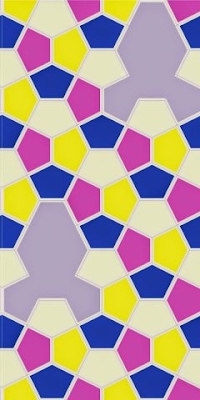 Josée Carrie I contacted Carrier, in 2014, to ask her about this, and found her most friendly and helpful. She told me that my site as the inspiration! She was previously unaware of the Cairo tiling, and found it ideal for her project: … When I started working on my fabric design. I was looking for a tile that could be assemble to form a spaceship. I thought it would be different using a different shape like a pentagon. This is when I started looking around on the internet and found your site. When I saw the Cairo tiling, I thought that was it. As soon I started making some sketch, I found out it was perfect for making a spaceship... Background Carrier has an engineering background, but also has a decided arts and craft interest, with sewing and quilting, and so she thus combines her interests to a common purpose. She has published several sewing and quilting projects in different magazines and is the co-founder of the Montreal Modern Quilt Guild. Her website is titled ‘The Charming Needle’. http://thecharmingneedle.com/2014/06/cosmic-voyage.html http://www.spoonflower.com/designs/3339792 Fibre Arts - Quilting/Patchwork/Paper Piecing, by Hilde Klatt and Liesel Niesner An instance of quiltwork/patchwork/paper piecing, in the German book Liesels Fünfecke: Inspiration & Anleitung für Fünfeckprojekte von Hand genäht nach Liesels Sechsecken-Technik, published by Ildico, 2006, by Hilde Klatt and Liesel Niesner. This translates as Liesels pentagons: Inspiration & Instructions for Pentagon Projects Sewn by Hand According to Liesel's Hexagonal Technique. This is described as: 228 pages of continuous color illustrations 32 new pentagonal line drawings as a design template … Hand sewing the grandiose pattern of Liesel's pentagons opens up a veritable treasure chest. In this rich book you will find more than 50 projects, from quilts to little things to murals. There are detailed instructions for reworking, many suggestions for variation, as well as inspiration and encouragement for your own designs. Liesel's pentagons are irregular pentagons that can be joined together to form a flat surface. The patterns are divided into the three sections... Book Cover, left; Pages 176-177, middle; Templates, right Ildico is associated with Hilde Klatt’s blog, and so it appears to be a self-published book, although not of the typical vanity type, as it is widely quoted. There also appears to be templates available arising from the book.
I have not been able to establish if there is a mention of the tiling in the book. Certainly, pp. 176-177 do not mention the association. Therefore, whether the use of the Cairo tiling is purposeful or accidental, the latter in the sense of a generic pentagon tiling is unknown. Having not seen the entire book, it would be unfair to speculate, but likely, given their background, they would be not familiar with the association. Aside from a strict Cairo tiling, instances are also shown of a Cairo tile in association with other polygons, on the front and back covers, and inside. And indeed, some are most interesting!
Klatt and Niesner have also authored another earlier book, of 2001 (of which the above book title alludes to), on hexagons, in the same style (with an English translation). Liesels Fünfecke thus obviously builds upon the success of the earlier book. I did not contact either of the authors.
Background Details Surprisingly little is known of Klatt and Niesner themselves. Indeed despite a website (Niesner) and blog (Klatt), there is next to biographical information on them at all! That said, Klatt’s blog is indeed expansive and she describes herself as: … designer and author, with a passion for color, form and textiles... The website, which serves to market the book, is very poor indeed, and is barely functional, although the book is indeed described relatively well.
http://www.liesels-ecke.de/ (A portal to Lieselei online store and HiIdes Ildicolor blog) https://www.shopssl.de/epages/es101247.sf/de_DE/?ObjectPath=/Shops/es101247_Liesels-Shop/Products/01189036 (Shop) https://ildicolor.wordpress.com/2012/09/22/shells-muschelquilt/ (pp. 176-177 of the book) https://ildicolor.wordpress.com/2012/09/22/shells-muschelquilt/ (pp. 176-177 of the book) The following are all quilts derived from the book, with the maker’s name in brackets: https://www.patchwork-quilt-forum.de/fuenfeck-decke-t4768.html (‘Maria’) https://domesticat.net/2015/08/new-pentagon-in-town (Amy Qualls) http://bastiansoma.blogspot.com/2010/06/5-eck-fieber-fische.html (‘bastiansoma’) https://klaudiaspatchwork.blogspot.com/2017/10/mein-sommergarten-quilt-3-blume.html (Klaudia Schumacher) Fibre Arts - 'Quilt' by Christiane Bettens, aka Mélisande An instance of ‘quilt’, titled ‘Cordovan pentagon quilt (opus XLV)’ by Christiane Bettens, aka Mélisande, an origamist, albeit included here with considerable reservation. Quite how best to assess, or interpret this instance is unclear: is it origami, quilt or a combination? I have decided to discuss under both. Here I discuss as a quilt. Indeed, a convincing case can be made for placing solely as origami, which much better describes this instance. Indeed, it is not a quilt at all (despite the initial impression of a quilt-like interior decoration), at least in the conventional sense! However, I have thus included here for the sake of thoroughness (and indeed place what I consider as a more proper placing as origami in that section as well). Curiously and confusingly at first glance to the non-origamist, Mélisande also has other works she titles as quilts, despite plainly (without the suggestive quilt-like interior decoration of the Cordovan instance) being origami! To the outsider of origami, as I was, this description at face value appears to be a quirk of Mélisande’s. However, I now see that this is an ‘official’ description of the origami world, and is freely used, and indeed there are books with the title. The Origami Resource Center gives: Given that origami has been around for over a thousand years, origami quilts is a relatively new branch of origami. Here, paper is folded into units and many units join to form beautiful, planar mosaics. These can then be displayed on a tabletop or hung up against a wall. Origami quilts may be considered a subset of modular origami. In modular origami, the models are usually polyhedra or stars. In contrast, origami quilts are flat and, in principle, can expand indefinitely. Because origami quilts are composed of many units joined side by side, they are reminiscent of tessellations. So there you have the explanation! Mélisande is aware of the Cairo tiling and directly refers to it as such, albeit briefly: Cordovan pentagon quilt (opus XLV) Inspired by Oschene's Cairo pentagonal knot. Angles of these pentagons are 135° 90° 112,5° 112,5° 90°, same as figure 3 on this page. So the cordovan is considered a subspecies of the cairo tiling. (Actually I found the reference after creating the unit myself) 71 pieces ‘Oschene’ is her friend, Philip Chapman-Bell. From her comments, the Cordovan attribution appears to have been applied retrospectively. This is the only instance in her origami/quilt work. I did not contact Mélisande. Background Details Christiane Bettens/Mélisande is prominent on Flickr, and has an extensive blog, ‘The Chronicle of Mélisande’, both under Mélisande (the explanation of the nom de plume is not given), albeit, and curiously, without any mention of her real name (and which initially hindered research)! She first became interested in origami in 2003 and has a tessellation interest. She comes from a family with a paper tradition, editing, printing, selling paper, but she did another choice for a profession, a primary care physician. https://www.flickr.com/photos/melisande-origami/7328846506 (Cordovan pentagon quilt (opus XLV)) https://www.flickr.com/photos/melisande-origami/albums/72157631972891733 (Cordovan quilts) https://origamiusa.org/thefold/article/origami-designers-secrets-christiane-bettens-m%C3%A9lisande (Interview) http://origami-art.org/blog/index.php?post/2008/01/01/3-about (About) Fibre Arts - Quilt, by Lynn Kline, ‘Monkey Needle’ An instance of quilt work by fibre artist Lynn Kline, of the US, as shown on her website ‘Monkey Needle’. This work was created in response to a ‘challenge’ of sorts, of an ‘adventurous’ nature, of a quilt without the typical geometrical shapes normally encountered in quilting, such as squares, triangles and hexagons. Pentagons, as regards the practical aspects of sewing, are a somewhat ‘awkward’ shape to incorporate into a quilt (which explains the decided paucity of them in this field). The quilt is described: But I don’t remember ever seeing a quilt made with pentagons… Then I found a picture of a pentagon bookcase and the idea for this quilt was born. On the top half of the quilt, the colored blocks and pieces are supposed to look as if they were sitting on a shelf of the bookcase. So the blocks are stacked, the books are laying at an angle, and the flower arrangement is lying on an angled shelf but not at the very edge. The bookcase, from the link given, can be seen to refer to the Quodes/Alfredo Häberli instance (see the bookcase section), although this is not stated as such. A pleasing feature is the ‘interior within’, with books and flower decorations adorning the shelves. The quilt, apparently of 2014, mimics the different sizes of pentagons on one of the bookcases. Although this is thus strictly not a Cairo tiling, it is included here as it is of a sufficient enough Cairo-like nature to be deemed an acceptable variation. No mention is made of the Cairo tiling on the page, and so whether the use of the Cairo tiling is purposeful or accidental, the latter in the sense of a generic pentagon tiling is unknown. However, without any apparent mathematical interest, likely Kline would be not familiar with the association. I did not contact Kline. Background Kline, of Western North Carolina, has many of the traditional interests in fibre art, of quilting, sewing, designing patterns, and crocheting. She has recently, in 2018, opened a shop, ‘A Stitch in Time’ dedicated to her craft, a culmination of a dream came true. https://monkeyneedle.com/tag/adventure/ Fibre Arts - Quilt, by Sami Casanova An instance of quilt work by Sami Casanova, of New York City, US, simply titled ‘red pentagons’, of 2008, as shown on his/her Flickr page (it is not clear if Casanova is male or female; Sami is seemingly used for both sexes. However, likely female, due to the ‘hatgirl’ reference in the Flickr URL. I will presume female in the text below). However, beyond this bare description, details on this work, and Casanova are next to non-existent. The work was created for Casanova’s three-year-old son, upon his request! Casanova describes herself as a ‘Quilting geometer’, and in the works shown some have a decided leaning towards mathematics, with tessellations and a Mobius band. And that’s about it, despite an apparent useful ‘about page’, which says nothing, but instead shows quilt images! Interestingly, this quilt is also discussed on the ‘A Nerd Quilts’ site, possibly by Casanova, but it’s hard to be sure! No name is given! However, the ‘about page’ lists her interests as quilting, knitting, math, puzzles, interactive fiction, and from which from a social media presence (Twitter) appears to be of Casanova. It is all most frustrating! Why people delight in obfuscation, intentional or not, is a mystery to me. No mention is made of the Cairo tiling on the page, and so whether the use of the Cairo tiling is purposeful or accidental, the latter in the sense of a generic pentagon tiling is unknown. From the Flickr page, it appears that Casanova would be unfamiliar with the association (as otherwise it would have been mentioned). However, the ‘A Nerd Quilts’ site shows a decided pentagon interest, of the pentagon types, with the Richard James III pentagon and in which the Cairo Pentagon is mentioned, so perhaps after all Casanova is familiar with the association. Who knows? I did not contact Casanova. Background Details As alluded to above, little is known. Indeed, all the background details have been incorporated into the above text, and so there is nothing more to say! https://www.flickr.com/photos/hatgirl/2351215997/in/photostream/ https://www.flickr.com/photos/hatgirl/2352043788/in/photostream/ https://www.flickr.com/photos/hatgirl/2352203517/in/photostream/ https://www.flickr.com/photos/hatgirl/2352205009/in/photostream/ https://anerdquilts.typepad.com/blog/quilts/page/2/ (scroll to the end of the page) Fibre Arts - Quilt, Pat Yamin, ‘Come Quilt With Me’ US An instance of quilt work by Pat Yamin, of New York, US, simply titled ‘Pentagon’, of 30½” x 38½”. Yamin, with her website (not searchable) ‘Come Quilt With Me’ has a geometric section, but oddly this instance is not there. Rather this is in the book Simple Super One-Patch Quilts, Collector Books, 2013. That said there is a variation on the website titled ‘Tipsy (sic) Turvy’, which is Cairo tiling in intent. Page from Simple Super One-Patch QuiltsNo mention is made of the Cairo tiling on the page, and so whether the use of the Cairo tiling is purposeful or accidental, the latter in the sense of a generic pentagon tiling is unknown. However, without any apparent ostensible mathematical interest, likely Yamin would not be familiar with the association. I did not contact Yamin. Background Pat Yamin, with an interest in quilts of more than 40 years, is president and founder of Come Quilt With Me, a family-owned business for 35 years, is well known in the quilting industry. She has authored books and has appeared on many television and radio quilt shows, the most recent being ‘The Quilt Show’ with Ricky Tims and Alex Anderson. Her company manufacturers templates and other tools that assure accuracy and shorten the time necessary to make a quilt, and since 2009 has organised quilt retreats throughout the US. Fibre Arts - Quilt, by Dorothea Lutgerink? An instance of quilt work ostensibly by Dorothea Lutgerink, a fibre artist of Groningen, the Netherlands, albeit much here as to the quilt and designer remains uncertain. Indeed, so much so that it is decidedly trying and frustrating to figure out ‘all’ here. The quilt was found on her Pinterest page (no commentary is given), link below, with a link to her blog. However, when clicked, I was unable to find the work! Her blog is most curious, with no posts, with links to other quilt and like blogs. Presumably, it is there, but I have no desire to wade through seemingly numerous blogs and pages to try and find it! Therefore, whether it is her work or not is unclear. She also shows another quilt work, partial, with a rabbit motif. Again, whether this is from here is uncertain. Apparently Lutgerink once had a website, but it is now closed. As alluded to above, no mention is made of the Cairo tiling on the page, and so whether the use of the Cairo tiling is purposeful or accidental, the latter in the sense of a generic pentagon tiling is unknown. However, without any apparent mathematical interest, likely she would be not familiar with the association. I did not contact Lutgerink. Background Little is known of Lutgerink. Basic detail is given on her Pinterest and Blogger pages. She was born in 1949 and enjoys the full range of fibre arts, namely of quilts, sewing, crochet, mandalas, embroidery, and knitting. Among her favourite books is Liesels Fuenfecke, see above, and so possibly this is where the quit was derived from. Also mentioned is Designing Tessellations, presumably a Jinny Beyer quilt reference. https://www.pinterest.co.uk/pin/193514115226362278/ (Quilt) https://nl.pinterest.com/pin/439734351097901929/ (Rabbit) https://www.pinterest.co.uk/lutilieselt/ (Background) https://www.blogger.com/profile/07833761633389321550 (Background) Fibre Arts - Crochet, by Sara Palacios An instance of crocheting by fibre artist Sara Palacios, of Villa Reducción, Cordoba, Argentina, as shown on her Etsy page ‘ColorfulLullabies’. The crochet is described as ‘Pentagonal flower Crochet Pattern’, and the pattern, rather than the product itself, is available as a PDF download. Palacios has an extensive craft and social media presence, particularly active on Ravelry and Flickr, Pinterest, and to a lesser degree on Instagram. In contrast to most of the entries on this page, reference is made to the Cairo tiling, with ‘It is inspired by the Cairo pentagonal tiling’ and so the use of the Cairo tiling is purposeful. This is derived from the Wikipedia reference. I did not contact Palacios. Background Sara Palacios has been making handcrafts since she was a child, but only started crocheting regularly in 2008. Previously she knitted for almost 40 years. Maths, art, nature, and everyday experiences are the source of inspiration for her creations. She likens crochet as to music. The single, double, triple and higher stitches are like notes of various lengths and its spaces like rests. She teaches crochet in Río Cuarto and also in her house amid her main occupation in computing. http://sarapalacios.com.ar/mantas/ (Website) https://www.etsy.com/ca/listing/150935616/pentagonal-flower-crochet-pattern-cairo (Cairo Crochet) https://www.ravelry.com/patterns/library/pentagonal-flowers (Cairo Crochet) http://sarapalacios.com.ar/mantas/index.php/category/matematica-y-ganchillo/ (Interview, 2013) Fibre Arts - English Paper Piecing, by Paper Pieces An instance of English paper piecing, as an acrylic template, from ‘Paper Pieces’, of Paducah, Kentucky, US, who supply various materials in the field, as a store and online. This is described as a ‘stretched pentagon’, and is available as a single pentagon in a variety of six sizes, with different side lengths, of ½”, ¾”, 1”, 1½”, 2”, 3” sides, with bases of ⅜”, 9/16”, ¾”, 1-7/16”, 2-3/16”, 1-⅛”. They have a largish website, which is searchable, and of which pentagons aside from the Cairo tiling feature heavily, perhaps more so than might be expected, albeit not all are single tilers. They have an extensive social media presence on Facebook, Instagram and Pinterest; indeed so much so that I did not reach the end of the pages! Acrylic Template No mention is made of the Cairo tiling on their site, and so whether the use of the Cairo tiling is purposeful or accidental, the latter in the sense of a generic pentagon tiling is unknown. However, despite the apparent mathematical interest as detailed above, likely they would be not familiar with the association. I did not contact Paper Pieces. Probably, for most people here, like myself, the intricacies and nuances of paper piecing are not generally known. The following, taken from Lina Patchwork, gives an excellent introduction: English Paper Piecing is a pure hand-sewing method used in traditional patchwork and quilting. The method involves the stabilisation of a fabric patch by fixating it to a heavy paper template (the ‘paper piece’). These stabilised fabric patches are then sewn together by hand into larger patterns, or quilt blocks, usually using an over-sew method. The paper pieces are removed when the shapes are sewn in on all sides and they can be reused for another project. The main advantage of English Paper Piecing is the fact that it is a very low-tech technique where few tools are needed, making EPP projects very ‘portable’. In addition, hand-sewing itself is seen by many as having a positive benefit on their overall wellbeing. The technique itself is easy to learn and only little tuition is needed to achieve great results. Foundation Paper Piecing on the other hand is generally done by sewing machine. The pattern, usually a whole block, is drafted directly on a sheet of foundation paper (or piece of muslin fabric). The block is then completed by sewing the fabric patches directly to the foundation paper using the stitch-and-flip method. On completion of the block the paper is removed by carefully tearing it away. Both techniques have their merits, as both enable the creation of stunning quits, sewing very complicated patterns with high accuracy. Foundation Paper Piecing is quite complicated and can be very challenging, particularly for a beginner in sewing. This method is best learned in a workshop under expert tuition. Background Little is known of the company. The 2019 catalogue states they have been in business for over twenty years, but the names and the number of the people involved are not stated. Likely it is a relatively small company of just a handful of people. And that’s about it! The six instances: https://www.paperpieces.com/3-4-Stretched-Pentagons https://www.paperpieces.com/1-1-2-Stretched-Pentagons https://www.paperpieces.com/1-2-Stretched-Pentagon https://www.paperpieces.com/1-Stretched-Pentagons https://www.paperpieces.com/2-Stretched-Pentagons https://www.paperpieces.com/3-Stretched-Pentagons For those in Germany it is also available online from Sue’s Quilt Shop: https://www.suesquiltshop.de/shop/index/product/Acrylschablone-Pentagon-unregelmssiges-Fnfeck-1-inch-mit-38-inch-Nahtzugabe_9657/sed/ Fibre Arts - Weave, Harry Nisbet An instance of ‘linear zigzag weave’, of some undoubted historical importance, of 1906, by Harry Nisbet, a textile authority of Bolton, UK, albeit quite how best to assess, or interpret this instance is unclear. This appears in the book Grammar of Textile Design, Chapter 10, pp. 77-102, ‘Diamond and Kindred Weaves’, p. 101, Fig. 276, albeit the diagram is not mentioned, never mind discussed as an entity in its own right, but rather in the context of other weaves, of Figs. 266-276. As such, there is essentially nothing as to detail its appearance, as a weave or of the pentagonal aspect. This is the only pentagonal instance. Nesbit states: ‘Figs. 266-276 are examples of linear zigzag weaves…’ and ‘Figs. 268-276 are examples of linear zigzag weaves based on this principle of weaving…’. A further oddity is the, or what appears to be, the underlying structure accompanying Fig. 276, below. As such, I do not see the correlation! The other figures are of the same presentation, with the same, to me at least, lack of correlation. Be all as it may, as alluded to above, historically this is significant, being one of the earliest appearances of the tiling. Of course, as this predates the first reference to the Cairo tiling, no mention is made in the context of the association with Cairo. Background Little is known of Nesbit himself, save for what institutional detail is given in the title pages in his books. No bibliographic detail is given. There is nothing on him at all on the web. The Grammar of Textile Design states on the title page: ‘Weaving and Designing Master, Municipal Technical School, Bolton’. He has also authored another book, On Sizing, which as well as mentioning his Bolton association also states that he is a member of The Textile Institute. (The Textile Institute is a professional body for those engaged in clothing, footwear, and textiles whose headquarters are Manchester, UK. The Institute was founded in 1910 and incorporated in England by a Royal Charter granted in 1925 and is a registered charity.) In Cotton Weaving and Designing he is one of the editors, along with Frederick Wilkinson, with John T. Taylor the author. This also mentions on the title page his Bolton association. Cotton Weaving and Designing is available on the Internet Archive (as is Grammar of Textile Design) and on the off chance of another pentagonal tiling appearing I searched, but to no avail. On Sizing does not appear to be available. Does anyone know more as to Nesbit, or can add to this entry? No detail is too small to mention. 6. Penta-graphene (1) Discovery A recent development (February 2015) concerning the Cairo tiling is in the form of a scientific discovery, of ‘Penta-graphene’. Researchers at Virginia Commonwealth University (VCU) and universities in China and Japan have discovered a new structural variant of carbon called ‘Penta-graphene’ – a very thin sheet of pure carbon that has a unique structure inspired by the Cairo tiling. The newly discovered material is a single layer of carbon pentagons that resembles the Cairo tiling, and that appears to be dynamically, thermally and mechanically stable and can withstand temperatures up to 1,000 K (730 °C; 1,340 °F). The background to discovery is relayed by one of the researchers, Qian Wang, Ph.D., a professor at Peking University and an adjunct professor at VCU, who was dining in a restaurant in Beijing with her husband when she noticed artwork on the wall depicting pentagon tiles from the streets of Cairo. 'I told my husband, "Come, see! This is a pattern composed only of pentagons,'" she said. "I took a picture and sent it to one of my students, and said, 'I think we can make this. It might be stable. But you must check it carefully.' He did, and it turned out that this structure is so beautiful yet also very simple." The researchers' paper, ‘Penta-Graphene: A New Carbon Allotrope’, will appear in the journal Proceedings of the National Academy of Sciences, and is based on research that was launched at Peking University and VCU.
Restaurant image © Qian Wang 7. Escher-like Cairo Tilings (2), by Alain Nicolas and Angie Leslie Some excellent Escher-like instances by the French artist, Alain Nicolas, and Angie Leslie (in the form of a jigsaw puzzle), of ‘Curious Minds’, based on the Cairo tiling. Other contributions are sought. Alain Nicholas Angie Leslie, of ‘Curious Minds’ Another, so far unique instance, is that of an Cairo Escher-like puzzle, of fish, by Angie Leslie of the US company ‘Curious Minds’, who specialise in creating unique educational learning toys for toddlers and preschoolers. These are commercially available, at the above address. (Note that this company is not to be confused with another of the same name, in Australia). To make clear the Cairo tile aspect, I have overlaid suitable lines. As such, this is the first such instance of a Cairo puzzle Escher-style, © Angie Leslie https://www.curiousmindsbusybags.com/collections/wooden-toys/products/cop 8. Ceiling Panels (3), of Davos Congress Centre, Switzerland; Ghemlamco Arena, Belgium and Tamara Lebanese Bistro Restaurant, Cairo Davos Congress Centre, Switzerland A significant sighting and indeed magnificent is at the well-known Davos Congress Centre, Klosters, Switzerland, opened in 1969, and the venue for world economic forums since 1971. The centre has subsequently undergone major transformations and extensions in 1979, 1989 and 2010. The 2010 extension saw the Cairo tiling installed as a honeycombed suspended ceiling at the new plenary hall (which is itself pentagonal) with a 1,800 delegate capacity. The lighting of the room, coming from inside the panels, makes the concrete structure have a very light appearance, as if the ribs they were floating, and making them look like mere decorative elements. The architectural style of Davos, with its famous flat roofs, echoes the installation. The cost of the build was 40 million Swiss Francs (£32 million). The hall was designed by Basel, Switzerland architects Degelo Architekten, founded by Heinrich Degelo. However, little, if anything, is known as to the background to this installation; the website has merely bare-bone detail (and without reference to the Cairo tiling), although a like presentation is seen throughout the site on other projects, and the architects did not answer my mail asking for more details. That said, this is discussed by Beatriz Fernández García, of the Universidad de Valladolid, Spain, where García asserts or at least implies, foreknowledge of the Cairo tiling by the architects, and so I will thus take this at face value the awareness of the architects. For the mathematical tourist, it is not entirely clear if the hall (and indeed the building at large) is open to the casual visitor. If any reader does visit, do tell me if this is visitable or not! Although it’s most unlikely, would any reader have details to add to the above? Of the architect, Degelo Architekten is a Swiss architecture firm founded in 2005 by the architect Heinrich Degelo, born 1957. It has won many awards. Geographically, Davos is a winter and summer resort village located in the heart of the Graubünden in the east of Switzerland. In the early 1990s, Davos became famous for hosting the World Economic Forum, an annual winter gathering of international politicians and financiers who represented a transnational elite. Together with the nearby town of Klosters, Davos offers a wide variety of winter sports activities, and summer hiking trails, set amid stunning Alpine scenery. https://www.davos.ch/en/davos-klosters/portrait-image/storytelling/architecture/ https://www.davoscongress.ch/en/for-visitors/ https://www.degelo.net/projekte/Erweiterung-Kongresshaus-Davos.php https://www.youtube.com/watch?v=eoHtlfx939M (This 5.08-minute video shows the construction of the hall from start to finish, of which the ceiling installation is at 2.12- 2.33) https://www.davos.ch/en/davos-klosters/meeting-place/congress-centre/ (This 1.38-minute video, upon an initial scroll, shows the interior of the hall, of which the ceiling installation is at 42-58 seconds) https://www.degelo.net/wAssets/docs/138_Degelo_Davos_A3-quer.pdf https://docplayer.es/68175201-Indice-1-el-porque-de-este-trabajo-3.html Ghelamco Arena, Belgium The Ghelamco Arena (began 2010, completed 2013, and named after the constructor), of Ghent, Belgium, a multi-use stadium (especially of the football club K. A. A. Gent), has a notable instance of the Cairo tiling, of modular pentagonal ceiling panels with acoustical sound absorption properties. This was designed by Mac Stopa of the Polish architectural practice Massive Design (founded 1996). The developer of the Ghelamco Arena, the Belgium company Ghelamco NV, commissioned Massive Design to provide the interior design for 20,000 sq. m. (200,000 sq. ft.) of the stadium’s interiors, including floor finishes, ceiling and lighting design. The Ghelamco Arena project also won an Interior Design Best of Year Honoree Award 2013 in the public space category. The modular pentagonal ceiling panels, of a ‘loose’ Cairo-tiling arrangement, have acoustical sound absorption properties, whose shape resembles the classic geometry of the stitched panels of a soccer ball. Approximately 10,000 Ecophon boards were cut to size and shape custom-designed by Mac Stopa. © Mac Stopa Stopa can undoubtedly be described as an enthusiast of the Cairo tiling, having used it extensively in a variety of architectural projects, great and small. (Another instance is at the Warsaw Spire Complex, Poland, and on clothing and wallpaper too. In addition to the orthodox presentation, these also involve variations of the design, where warping is evident.) However, there is no mention of the connection as to the Cairo association is made on the site and elsewhere, and so whether the use of the Cairo tiling is purposeful or accidental, the latter in the sense of a generic pentagon tiling is unknown. But Stopa must surely unaware of this association. Indeed, it may very well be stated, but if so among the vast amount of writings/publicity available on this project I have not been able to find this. I have previously contacted the practice (of 2015) in regards of the Ghelamco Arena, Ghent, Belgium, and of which although I received a polite and helpful reply, this was relatively brief, and would appear likely to have been overseen by office personnel rather than Stopa himself. My email primarily concerned photo permissions, rather than matters of his knowledge of the Cairo tiling as such, although I did mention the Cairo tiling by name. I should have been more specific! Although it would indeed be interesting to hear more details why he favours the Cairo tiling so much, in the light of this reply I have decided not to pursue further queries. Background Mac Stopa is an award-winning architect and designer, whose work spans several design disciplines: architecture, interior design, industrial design, art, graphic design and fashion. He is known for designing modern, innovative and functional interiors that reflect and enhance a company’s corporate image. The practice has won 66 international design awards. It is stated that he has an interest in mathematics and geometry. He seems to have acquired a degree of fame, with many published articles on him and interviews. He has an extensive social media presence on Facebook and YouTube. Stopa (and his wife, Dana) both seem to be lively characters, with their designs modelled by themselves on (colourful) clothing. He is also an electric guitar player and a music composer! About Ecophon Saint-Gobain Ecophon develops, manufactures and markets acoustic products and systems that contribute to a good working environment by enhancing peoples’ wellbeing and performance. Ecophon has business units in 14 countries, delegations in another 30 countries worldwide, and approximately 800 employees. The head office is located in Hyllinge, just outside Helsingborg, Sweden. Ecophon is part of the global Saint-Gobain Group. http://www.ghelamco.be/site/w/news-view/57/ghelamco-arena-wins-annual-interior-award.html http://massivedesign.pl/Awards/ghelamco-arena-ghent-belgium-interiors-project-by-massive-design-wins-interiors-award-2014-2/ https://www.worldarchitecturenews.com/article/1514709/ghelamco-arena Tamara Lebanese Bistro Restaurant, Cairo Some interesting and indeed novel use is to be seen at the Tamara Lebanese bistro, in Cairo, with numerous geometric patterned panels suspended from the ceiling, one of which includes the Cairo tiling. Such an instance gives credence as to its being a traditional Islamic tiling, although there is scant evidence of this. Upon enquiring with the company, of a Lebanese premise, on the possibility of these being from the Lebanon, they told me that these were simply generic Islamic designs. 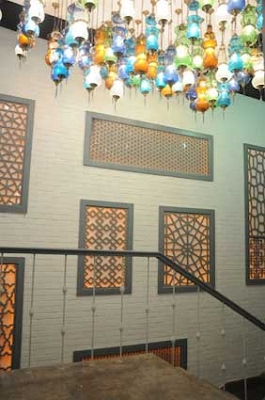 9. Ironing Board Cover (1), IKEA Jäll Tabletop 10. Bow Tie (1), by Le Noeud Papillon, Sydney, Australia Le Noeud Papillon, a bow tie company, of Sydney, Australia, has among their range two silk bow ties, of a pentagon theme, one of the recent (2015) Type 15 pentagon discovery, and another of a Cairo tiling. This is a limited edition of twenty, with a price of $165. 11. Cushion (1), from Macy's, New York, US A cushion, available from Macy's, of New York, US, and other stores 13. Pavement Drawing (1), Pan-American games, Toronto, Canada Pan-American games, Toronto, July 2015 14. Chairs (2), 'Bretzel Love’ Café Chair, Paris, France and Monsieur Meuble, a French furniture chain store 'Bretzel Love’ Café Chair, Paris, France Monsieur Meuble, a French furniture chain store A unique sighting is of a chair, from ‘Monsieur Meuble’ a well-known French furniture store and chain of over 40 years old, with branches all over France. The chair appears to have been part of a liquidation sale. Does anyone know more on this? I have no other details. 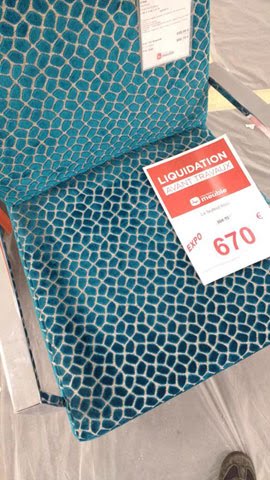 © Vincent Pantaloni 15. Torus (1), by Kenneth Peel The Cairo tiling realised as a 3D model onto the surface of a torus by Kenneth Peel, a student of mathematics at Bellingham, Washington state, US. © Kenneth Peel 16. Kimono (1), by Moriguchi Kunihiko An interesting sighting, the first of its type, comes from the world of fabric/clothing, with a Kimono by Moriguchi Kunihiko (1941-), of Japan. This was a part of an exhibition on Kimonos at Paris in 2016 from November 16 to December 17, 2016, at the House of Culture of Japan to Paris. Kunihiko is a household name in Japan and has acquired a degree of fame, described as a ‘living treasure’ of Japan. 17. Canopy (1), Maple Leaf Square, Toronto, Canada A pentagonal tiled canopy (inspired by the experience of walking through a forest’s dappled light) by United Visual Artists (UVA) a London-based art practice, of a 90-metre long light sculpture spanning the front facade of the Maple Leaf Square building in Toronto, Canada, of 2010. Their form, abstracted from the geometry of leaves, reflect nature. Whether the designer was familiar with the Cairo tiling is unclear; it is not mentioned on their web page, and a mail asking for further details to UVA went unanswered. Of note in the panoramic view is the famous landmark the CN Tower in the background. 19. Wine Racks (1), by Grassi Pietre, for Zýmē Winery, San Pietro, Italy An unusual, and indeed unique instance, is by Grassi Pietre architects, for Zýmē Winery, of San Pietro, Italy, with the pentagons used as series of wine racks, in stone, with the wine bottles stored in a vault in a cave, as temperatures must remain constant. The use of pentagons is predicated on the logo of the company, of a wine leaf in the broad shape of a pentagon. Each pentagon measures 78 x 56 x 60 cm and weighs 85 kg. © Daniele Domenicali 20. Origami (2), Ron Resch - Folded Paper Ron Resch (1939-2009) was a renowned artist, computer scientist, and applied geometrist, known for his work involving folding paper, origami tessellations and 3D polyhedrons. He famously designed the ‘Vegreville egg’, the first physical structure designed entirely with computer-aided geometric modelling software. Among his folding paper creations was a Cairo tiling, of a ‘folded mosaic’ titled ‘Bar-Bell Yellow’, possibly of 1963. For this, and other paper foldings of his, see: 22. Coffee Table (2), by Monzer Hammoud, Pont des Arts, Paris, France http://www.pontdesarts.biz/ 23. Exhibition stand (1) by Institute for Lightweight Structures and Conceptual Design (ILEK), Stuttgart, Germany https://www.dezeen.com/2009/05/20/3d2real-by-ilek-students/ 24. Coffee table, by Francesco Caracciolo di Marano and Sam Robin, founders of Robicara company, US http://robicara.com/galleries/pentagon-coffee-table/ 26. Acoustic Walls (2) Fluffo, Poland Fluffo, of Borzecin Duzy (near Warsaw), Poland, founded in c. 2014, is a relatively small company who describe themselves as a manufacturer and supplier of acoustic wall panels, of flexible, dense polyurethane foam, with the finish resembling velvet. They have an extensive website in Polish and an English option but is not searchable and a social media presence on Facebook, Pinterest and Instagram. They market the Cairo tiling (of a ten-panel range) as ‘Fluffo SOFT’, as wall panels only. The range is described: Fluffo SOFT is a collection of decorative, soundproofing wall panels, available in a wide selection of colours, shapes and thicknesses. They soundproof a room in a beautiful and stylish way. With Fluffo SOFT you can enjoy a cosy, quiet and most importantly, beautiful interior. This is primarily marketed in Poland, available directly from themselves or distributors as well as other European countries, but only as a token presence; the UK has only one supplier. The Cairo tiling is titled, curiously, as ‘Chain’, without reference to a pentagon tile (as an aside, quite how I found this is a mystery!), albeit is not strictly of a single pentagon, but is rather fused, of a (slight) incline, albeit differentiated by colour. It is available in 52 colours, of four blues, four yellows etc. The angles and side lengths are not stated, although the height and width are, 367 x 550 mm, with a thickness of 20-50 mm. It is not known when the Cairo tiling was introduced into their range. Given the widespread nature of the company, one would expect the tiles to feature in many homes, not just in Poland, but if so I have not seen any; all I have seen are as marketed, or supplied, by the company. No mention of the connection as to the Cairo association is made on the site, and so whether the use of the Cairo tiling is purposeful or accidental, the latter in the sense of a generic pentagon tiling is unknown. Likely they are unaware of this association. I did not contact the company, judged that they would likely not respond, fairly or unfairly, of a non-commercial query. Company details and background Fluffo, of whom the founder’s name and exact date (from a start around 2012 before a company as such about 2014) remain unclear, make a great play on that the panels were invented, designed and produced in Poland. The work, originally in their garage, on the implementation of their first collection of panels, mastering the technology processes and the creation of Fluffo marketing took almost 1½ years. The main part of the production process is done manually. The technological process – even though known for decades – is extremely difficult to automate. Since the founding, they have produced over 200,000 panels. The number of employees is not stated. No other relevant detail is given. http://fluffo.uk/en/at-home/fluffo-soft-soft-wall-panels Acoustic Walls (2), by Kamilla Lang Hermansen https://www.behance.net/gallery/273966/Pentagon 27. 'Pentagonal Framework' (1), by Adriel Designs An interesting, and unique instance, is of a ‘pentagonal framework’ interior, on the 90m luxury motor yacht ‘Lumen’, designed by Adriel Designs, of the US, an interior design firm, for the prestigious Dutch luxury yacht builder oceAnco, although the exact circumstances as to the installation are a little hazy. John Cantu, of Nautlis3D, is also seemingly involved in the project. Upon seeking more details, a mail to Adriel Design went unanswered, although Cantu responded. Unravelling the somewhat tortuous background with so many people and institutions involved is a task in itself, and of which I largely refrain from! This being so, the background details here are subject to revision. More details are given at the link above. © John Cantu28. Board Game (1), ‘Cairo Corridor’ by Markus Hagenauer Another unusual instance is that of a board game, titled ‘Cairo Corridor’, by Markus Hagenauer, of Germany. This is commercially available, at Nestorgames, under the auspices of Néstor Romeral Andrés: 29. Shelving Unit (1), by Alexander Pincus Alexander Pincus, an US architect, in 2013 designed a new series of steel and walnut furniture with the appropriately named ‘Cairo’ that explores a recurring hexagonal pattern. Elements include large and small display shelving, low cabinets, a credenza, and a room divider. © Alexander Pincus30. Origami, by John Szinger Another unusual instance is that from the field of origami. This instance, of 2009, is by John Szinger, of the US, an authority on origami, with books to his name, notably Animal Origami Sculpture. © John Szinger31. Origami, by David Mitchell http://www.origamiheaven.com/tiles.htm
Origami, by Christiane Bettens, aka Mélisande An instance of origami, although not obvious from the title alone, ‘Cordovan pentagon quilt (opus XLV)’ by Christiane Bettens, aka Mélisande, an origamist. The quilt aspect in the title here is a little confusing, as it is not a quilt at all (despite the initial impression of a quilt-like interior decoration), at least in the conventional sense! However, there is indeed a relation. There is a relatively recent branch of origami titled ‘origami quilts’, from which this is where the title is taken. In short, folded origami units are combined to form a ‘quilt’. Quite how best to assess, or interpret this instance is unclear: is it origami, quilt or a combination? I have decided to discuss under both. Here I place as origami. Mélisande is aware of the Cairo tiling and directly refers to it as such, albeit briefly: Cordovan pentagon quilt (opus XLV) Inspired by Oschene's Cairo pentagonal knot. Angles of these pentagons are 135° 90° 112,5° 112,5° 90°, same as figure 3 on this page. So the cordovan is considered a subspecies of the cairo tiling. (Actually I found the reference after creating the unit myself) 71 pieces ‘Oschene’ is her friend, Philip Chapman-Bell. From her comments, the Cordovan attribution appears to have been applied retrospectively. This is the only instance in her origami/quilt work. I did not contact Mélisande. Background Details Christiane Bettens/Mélisande is prominent on Flickr, and has an extensive blog, ‘The Chronicle of Mélisande’, both under Mélisande (the explanation of the nom de plume is not given), albeit, and curiously, without any mention of her real name (and which initially hindered research)! She first became interested in origami in 2003 and has a tessellation interest. She comes from a family with a paper tradition, editing, printing, selling paper, but she did another choice for a profession, a primary care physician. https://www.flickr.com/photos/melisande-origami/7328846506 (Cordovan pentagon quilt (opus XLV)) https://www.flickr.com/photos/melisande-origami/albums/72157631972891733 (Cordovan quilts) https://origamiusa.org/thefold/article/origami-designers-secrets-christiane-bettens-m%C3%A9lisande (Interview) http://origami-art.org/blog/index.php?post/2008/01/01/3-about (About)Origami, by 'Arseniy K' An instance of origami, simply titled ‘Cairo Tile’, of 2019?, by ‘Arseniy K’ (or Ko, or Koom, he seems to have a variety of name variations), who describes himself as a ‘Paper Alchemist & Origami Designer’. As with his name, much is unclear as to the background here. Seemingly little is known of the artist, save that he appears to be Russian. He is prominent on Flickr and Instagram but does not appear to have a website. His ‘About’ page on Flickr merely gives a link to his Instagram page! His work appears to be strictly ‘mathematical origami’, with a variety of tilings; I did not find any animals, as is often seen in origami. All that accompanies the work, on Flickr, is: I kind of managed to recreate the Cairo tiling, which is type 4 pentagonal tiling, wiki gives more detail on that. And that's one of my few works that has only two-way symmtery [sic]. An open question is to how difficult it is to fold a Cairo tiling. And following on, are there different ways? Ko is aware of the Cairo tiling and directly refers to it as such, as above. I did not contact him. Background As alluded to above, there is nothing more to say; all that is known is as given above! https://www.flickr.com/photos/arseniyko/47747795371/in/faves-32618149@N00/ Origami, by Rob Foord An instance of origami, by Rob (or Robert) Foord, of Gloucestershire (at least of 2005), United Kingdom, an origamist of an international reputation in the field. However, much detail as to Foord and this instance of the Cairo tiling is unclear. I have a reliable account of this appearing in the magazine ‘British Origami Society’ (BOS) 315, April 2019, p. 10. As such, this can be considered as one of the more important instances of origami, as it has appeared in a publication. However, I have not been able to find a picture, and I lack the time and will to join the society to access this publication. Little details on Foord himself are known. His BOS entry merely gives: Rob has been creating designs for many years and his style has obviously changed. He currently works primarily with geometric designs, but this [non-Cairo tiling] is an early creation from the 90s. I have not found other details of Foord than that given above. He does appear to have a social media presence on Facebook and Twitter. As mention is made of the Cairo tiling on the reference, the use of the Cairo tiling must have been purposeful. Among his creations (the BOS database gives 25), are other mathematical instances, and so it appears that Foord has a mathematical interest, albeit to what extent is unclear. I did not contact Foord, notwithstanding that his contact details seem unavailable! Background As alluded to above, all the detail I have is discussed above, and so there is nothing more to add!
https://www.britishorigami.info/society/british-creators/rob-foord/ https://www.giladorigami.com/origami-database/cairo%20tiling 33. Crowne Plaza Hotel, Den Haag, The Netherlands © Christian Perfect-Lawson 34. Panelling, Bayer Office, Buenos Aires, Argentina Panelling, at Bayer pharmaceuticals company, Buenos Aires, Argentina, 2018, by design lead Andrea Símboli of Contract Workplaces, a South American workplace design and construction company. Contract Workplaces were engaged by the major pharmaceutical company, Bayer, to create a new design for their office located in Buenos Aires, Argentina. More pictures and detail are at: https://officesnapshots.com/2018/10/18/bayer-offices-buenos-aires/ Picture credits Contract Workplace, photographer Andrés Negroni. Thanks to Celeste Grecco of Contract Workplaces for permissions. © Contract Workplaces 35. Fabrics, JAB Anstoetz Group, of Germany JAB Anstoetz Group, of Germany describe themselves as ‘medium-sized family business that has stood for stylish living and been associated with precious fabrics since 1946’. The size is somewhat of an understatement, as the company employs 1,300 people! Their products range from sunshades, wallpapers, floors and furniture. They have a searchable website. They market the Cairo tiling as a fabric simply titled ‘Penta’ (a common description, often seen in floors and wall tiles)’, 100% polyester. This is available in three colours, or is at least stated as such; the page merely asserts this but does not show. This is easily available, with worldwide distribution; there are over 100 outlets in the UK alone. I must admit, despite such a widespread presence in the UK, I had never heard of them until now! It is not known when the Cairo tiling was introduced into their range. No mention of the connection as to the Cairo association is made and so whether the use of the Cairo tiling is purposeful or accidental, the latter in the sense of a generic pentagon tiling is unknown. Likely they are unaware of this association. The angles and dimensions of the tile are not known. I did not contact the company, judged that they would likely not respond, fairly or unfairly, to a foreign, non-commercial query. Company details and background Josef Anstoetz writes the first chapter of the company history. Under the name JAB – the abbreviation for Josef Anstoetz Bielefeld – the merchant uses his affinity for textiles and in 1946 opens a wholesale company for decoration and upholstery fabrics. After just three years the business is so successful that the rented premises in the "Spinnerei Vorwärts" have become too small. To enable further expansion the company moves to Rohrteichstraße 35a. The year 1955 is overshadowed by the sudden death of Josef Anstoetz. As his successor, Heinz Anstoetz takes over the management of the flourishing company. In 1959 the foundation stone is laid for a new building in Bielefeld-Oldentrup. Potsdamer Straße 160 becomes the new headquarters of JAB. The first showrooms are opened in Germany. In 1961 the focus is on the systematic development of the export market. The high-class home textiles and upholstered furniture of JAB also arouse great interest beyond the German borders. With the opening of JAB International Furnishings in 1979, the family business establishes itself in the British interior market. In 1996 Heinz Anstoetz celebrates his 50th company anniversary and then retires from operational business life. After his death in 1998, the company is renamed JOSEF ANSTOETZ KG. A series of takeovers and acquisitions continues in the 2000s and to the present day. The company continues to grow and now employs 1,300 people. https://www.jab.de/gb/en/Collection/Perla/PENTA/p/9-7811-070 36. Panels, Laminam Star Maker, by Mac Stopa of Massive Design, Poland The somewhat curiously named ‘Laminam Star Maker’, by Mac Stopa of the Polish architectural practice Massive Design (founded 1996), is described as a ‘quartz-based panel’, and makes use of the Cairo tiling as ‘small elements’, so small that from any distance that they are not discernable! This is described as: Laminam Star Maker is a three-dimensional puzzle made up of pentagonal stars, built into a larger-scale, hexagonal tessellation However, as such, it's not a puzzle in the conventional sense and there are no stars (or at least as I can tell)! The panels are 100cm x 300cm, which can be divided into three modular 1m x 1m tiles. By moving or turning adjacent tiles (as seen in the video below), many multiple geometric expressions are achieved. These large, thin and perfectly flat stain-resistant quartz panels are ideal for floors, walls and stairs in public areas and in residential projects and for both indoor and outdoor applications, including elevations in large scale architecture. The Laminam Star Maker slab won the highest award in the Red Dot Award: Product Design 2016 competition (called as the Oscars of Design). The Red Dot jury granted this product the most prestigious ‘Red Dot: Best of the Best’ award. The winning product has been developed in cooperation with Laminam Poland, who manufacture the panels. The first building in which the Laminam Star Maker slab was used is the modern office complex Warsaw Spire, Poland (see ‘As Architecture’ page).
As to technical matters, Laminam sintered quartz is a composition of natural materials, and in particular quartz, shale clays, granite rocks and ceramic pigments. Granules from the above raw materials are first pressed. Then, innovative sintering granulate is used, which is fired at a temperature of 1220 degrees. This method creates large-format Laminam boards that are perfectly flat and can be cut to a specific size with very high accuracy. Stopa can undoubtedly be described as an enthusiast of the Cairo tiling, having used it extensively in a variety of architectural projects, great and small. (Another instance is at the Ghelamco Arena, Belgium), and on clothing and wallpaper too. In addition to the orthodox presentation, these also involve variations of the design, where warping is evident.) However, there is no mention of the connection as to the Cairo association is made on the site and elsewhere, and so whether the use of the Cairo tiling is purposeful or accidental, the latter in the sense of a generic pentagon tiling is unknown. But Stopa must surely unaware of this association. Indeed, it may very well be stated, but if so among the vast amount of writings/publicity available on this project I have not been able to find this. I have previously contacted the practice (of 2015) in regards of the Ghelamco Arena occurrence, and of which although I received a polite and helpful reply, this was relatively brief, and would appear likely to have been overseen by office personnel rather than Stopa himself. My email primarily concerned photo permissions, rather than matters of his knowledge of the Cairo tiling as such, although I did mention the Cairo tiling by name. I should have been more specific! Although it would indeed be interesting to hear more details why he favours the Cairo tiling so much, in the light of this reply I have decided not to pursue further queries. About Mac Stopa Mac Stopa is an award-winning architect and designer, whose work spans several design disciplines: architecture, interior design, industrial design, art, graphic design and fashion. He is known for designing modern, innovative and functional interiors that reflect and enhance a company’s corporate image. The practice has won 66 international design awards. It is stated that he has an interest in mathematics and geometry. He seems to have acquired a degree of fame, with many published articles on him and interviews. He has an extensive social media presence on Facebook and YouTube. Stopa (and his wife, Dana) both seem to be lively characters, with their designs modelled by themselves on (colourful) clothing. He is also an electric guitar player and a music composer! About Laminam Laminam is a producer of large format plates made of sintered quartz. The company was founded in 2001 (by whom is not stated) and for several years has built an extremely strong position in the broadly understood ‘home and interior’ industry. Its products are known all over the world, and for several years the brand is also present in Poland. In Warsaw, you can visit the only Italian showroom in this part of Europe. http://massivedesig.nazwa.pl/Awards/star-maker-by-mac-stopa-for-laminam-wins-red-dot-design-award-best-of-the-best-2016/
https://www.youtube.com/watch?v=aRM4Ei7f3ls&feature=youtu.be
Cairo tiling featured throughout, 2.25 minutes
http://laminam.com.pl/component/k2/47-aktualnosci/red-dot-star-maker| 37. Pouffe, by Patrica Lascano, Argentina Patricia Lascano of Argentina has a self-named design studio of which she markets a variety of interior design items, including seats and chairs. She has a website and a social media presence on Facebook and Instagram. She markets the Cairo tiling (or what appears to be) as a pouffe (a cushioned footstool or low seat with no back). The pouffes themselves are evidently (from the images) designed to tile, which is a pleasing feature, although of course serve as single (utilitarian) furniture in themselves. Little detail is given on Lascano’s site and is without any reference to a pentagon, and what detail is given is largely inconsequential. She states: Terron. Inspired by mathematic paterns (sic), these pouffs offer a number of different design combinations and could also create a infinite surface. ‘Terrón’ translates to ‘lump’ or ‘clod’, with another meaning as ‘cube’. Possibly this is a sideways reference to pouffe lost in translation. This is also described as the ‘Deseo Project’ but quite what this is unclear. A search on this term gives ‘child sponsorship’. Elsewhere, on external sites, the pouffe is described as ‘penta tesela’.
As alluded to above, it is not entirely clear if the tiling here is of a Cairo tiling, but it is hard to be sure; the pattern (fabric) appears to be ‘stretched’, and so thus distortions arise. Strictly, upon closer observation likely not. An individual pouffe can be seen to echo the pentagon in outline (and is a nice feature in concept), and of which, seen at this larger, ‘undistorted’ scale, this is thus not a Cairo tiling. That said, if not it is obviously related to the Cairo tiling, with the ‘secondary’ hexagons (consisting of four pentagons) at right angles in a typical Cairo manner, and so I have thus decided to include here. This is primarily marketed in Argentina, although exactly where is not clear! Possibly they are available from ‘Wide’, with ‘Widestore’. It is available in two colours, yellow and dark grey. The angles and side lengths are not stated. It was introduced into her range in 2015. No mention of the connection as to the Cairo association is made on the site, and so whether the use of the Cairo tiling is purposeful or accidental, the latter in the sense of a generic pentagon tiling is unknown. Likely she is unaware of this association. I did not contact Lascano, of which although as an individual I would more likely receive a reply than a major company I decided not to bother. Design Studio details and background Patricia Lascano describes herself as an industrial designer since 2001. Her designs are produced and commercialized in Argentina and Brazil. Her products have several awards and some of them are part of the Argentine Design Collection of the Museum of Modern Art in Buenos Aires MAMbA. No other relevant detail is given. http://www.estudiolascano.com/ Click on enter, and then scroll a little to the pouffe pictures. Clicking on the ‘strip’ at right gives individual pictures. https://wideonline.com.ar/diseno/penta-tesela-salon-deseo-faima/ http://www.deseo.com.ar/catalogo/pentatesela/ 38. Wall Art (1), by Pier Paolo Spinazzè, Italy Pier Paolo Spinazzè, of Italy, an artist and designer who describes himself as a wall designer, makes extensive usage of the Cairo tiling as wall art. He has a website, albeit primarily he is more prominent on social media with Facebook. Oddly, despite an undoubted interest in the Cairo tiling (and indeed other pentagon tilings), although the Cairo connection is acknowledged (although incorrectly, with ‘souks’) this is not detailed as such on his site or Facebook page. As alluded to above, many instances can be seen, of which perhaps the most impressive is that on a Beetle car. Other instances include the company MGM Minerbe and at Veronafiere SpA - Fiera di Verona I contacted Spinazzè, of this 2019 inclusion (with a translation), and previously, but he did not respond to requests for photo permissions and specific background details. Background Pier Paolo Spinazzè, born 1982, has since 1998 dealt with the creation of murals, street art, and graffiti, a passion that he has been able to turn into work. No other relevant detail is given. https://www.facebook.com/pg/ilpierdesign/photos/?ref=page_internal 39. Wall Art (2), by Joseph Warren An instance of wall art, titled ‘CAIRO’ (capitalised as in the original), of which determining the originator and background is not easy, and of which the story is decidedly tiresome to unravel, with scant detail available and much obfuscation. Therefore, the text below is subject to revision. That said, from what little detail there is, or can reasonably be surmised, the designer appears to be Joseph Warren, of the UK, whose name is associated with this on the commercial Saatchi Art site (the world’s leading online art gallery). The art is titled ‘CAIRO No. Eighteen No. 1’ (as according to the number of tiles), of the inflated price (of which Saatchi is renowned for) of £743! It would indeed be interesting to know if this sold! This is described as: Installation: Paint, Enamel, Stencil on Steel. One of a series of unique painted steel artworks. CAIRO artworks are inspired by the tessellating pentagonal tiles found on pavements in the Egyptian capital. Exploring a modern industrial aesthetic, CAIRO pentagons are formed from steel and copper, and given a playful variety of surface treatments. The result is a collection of striking, three-dimensional geometric artworks with endless permutations, and timeless appeal. Fits to wall with magnetic fixings which are included. The wall art is also marketed on the commercial site ‘Image Surgery’ (seemingly related to Saatchi). This is described as: CAIRO Four Nº1 £120.00 (but out of stock as of this 2019 writing) Three-dimensional geometric artwork inspired by the tessellating pentagonal tiles found on pavements in the Egyptian capital. CAIRO is a series of artworks inspired by the tessellating pentagonal tiles found on pavements in the Egyptian capital. Exploring a modern industrial aesthetic, CAIRO pentagons are formed from a variety of materials and given experimental surface treatments. The result is a collection of striking, three-dimensional geometric artworks with endless permutations, and timeless appeal. CAIRO artworks are supplied with concealed magnetic wall fittings for invisible mounting. The designer, presumably Joseph Warren, is thus aware of the Cairo association, and so the use of the Cairo tiling is purposeful here. Apparently, the art was exhibited at London Design Fair, possibly of 2017, from a Joseph Warren Twitter retweet, although details here are next to non-existent; I was not able to find the reference on their site. The Saatchi and Image Surgery sites show different versions. On the Saatchi site, the tiles are coloured curiously, within an overall blue, green and black premise, with single pentagons of blue, green and black and other tiles with arbitrary divisions and circles. The Image Surgery site has single pentagons of blue, red and orange and black and white stripes, with geometric symbols overlaid, of an arrow, equilateral triangle a U shape and circles, all in contrasting colours. Both colouring schemes are arbitrary and baffling! I did not contact Image Surgery, Saatchi Art or Joseph Warren. I judged that Image Surgery and Saatchi Art would not reply, and as for Joseph Warren I simply gave up; he obviously doesn't want to be contacted, detailed below! But why be active on Twitter? It is all most strange. Each to his own... More than most entries here, this entry, of various trying aspects, is undeserving of my time and largesse. But there you go; it is now documented. Background Joseph Warren Warren himself, presumably a designer of sorts, is somewhat of a mystery! The only details given on his Saatchi page are his location, namely Colchester, Essex, United Kingdom! His Twitter page likewise gives no detail and is without contact details! No other relevant detail is given. Saatchi Art Saatchi Art, based in Los Angeles is the world’s leading online art gallery, connecting people with art and artists they love. Saatchi Art offers an unparalleled selection of paintings, drawings, sculpture and photography in a range of prices, and it provides artists from around the world with an expertly curated environment in which to exhibit and sell their work. Image Surgery Limited edition prints, letterpress cards, original artwork and functional homeware designed and produced in England for worldwide art and design insiders. London Design Fair The largest collection of international designers, brands, country pavilions, features and exhibitions in one destination. Located in the creative heart of East London, the London Design Fair is a four-day industry event that brings together 550 exhibitors from 36 countries. https://twitter.com/joseph_lucien (see 30 January 2017 retweet) https://www.saatchiart.com/art/Installation-CAIRO-Eighteen-N-1/6632/3230640/view https://imagesurgery.com/product/cairo-four-no1/ 40. Wall Art (3), of 'Litton Lane' Range An instance of wall art, from the ‘Litton Lane’ range, of two pieces titled ‘Yellow and Brown Wooden Honeycomb Wall Decor’, 28 in. x 28 in, for $57.42, and ‘Rustic Geometric Patterns Wooden Wall Decor in Stained Brown’, 35 in. x 35 in, for $76.00. This is available from The Home Depot, US (the largest home improvement retailer in the United States, although unknown in the UK) and likely other outlets too, as Litton Lane is frequently mentioned, although I have not found more instances of the Cairo tiling art here. This is respectively described as: This square wall art made of Chinese fir wood and MDF features a geometric pattern of interconnected pentagons in black, brown, and gold that complement shabby-chic-inspired design themes. The simple, geometric design and square frame of this wall art blend well with modern-style theme settings. This wall art comes in distressed colors and finishes that add a distinct rustic vibe to interior design themes. and This wall plaque features geometric-shaped accents crafted of fir wood. It features distressed brown, yellow and white finishes that will look great on your rustic and traditional home settings. This decorative piece is enclosed in a sturdy wood frame with a distressed brown finish that can be hung easily on your wall. Oddly, both instances list just three colours, but this is incorrect, each instance has four colours; a light brown and blue colouring were inexplicably omitted here. No mention of the connection as to the Cairo association is made on the Home Depot page and so whether the use of the Cairo tiling is purposeful or accidental, the latter in the sense of a generic pentagon tiling is unknown. Likely the (non-stated) designer is unaware of this association as this would have otherwise have been stated. A curiosity here is that the ‘Yellow and Brown…’ instance has a picture that is not a Cairo tiling as such, as the angles here are clearly not 90°, albeit close. Likely, given the true Cairo tiling, the (non-stated) designer misrepresented the Cairo tiling. Whatever, uncertainties aside, as this nonetheless is very much as a Cairo tiling in appearance, I have thus decided to include, of which I describe as a ‘near miss’. I did not contact The Home Depot, judged likely that from a major conglomerate I would not receive a reply. Background Details Litton Lane is apparently a title given to a wall art range, of which The Home Depot gives 107 items. As such, I was unable to find any more detail on the name. The Home Depot was founded in 1978 and is the largest home improvement retailer in the United States, and indeed the world, supplying tools, construction products, and services. https://www.homedepot.com/p/Litton-Lane-28-in-x-28-in-Yellow-and-Brown-Wooden-Honeycomb-Wall-Decor-98727/302267119 https://www.homedepot.com/p/Litton-Lane-35-in-x-35-in-Rustic-Geometric-Patterns-Wooden-Wall-Decor-in-Stained-Brown-59461/301937063 41. 'Pedestal', by Buzon, UK Buzon, an adjustable pedestal company from Middlesex, UK, uses the Cairo tiling in an essentially peripheral way, with other pavers to show exemplars for their pedestals. Therefore, much more so than other entries here, this inclusion is open to question, as the product is not specifically on the Cairo tiling. Indeed, a more than fair case can be made for its omission, or perhaps at best a mention in passing. However, as I have researched it, and as the company show an illustration, perhaps against my better judgement I have decided to include. In effect, this entry is merely a brief note as to have seen this. As alluded to above, this is merely an illustration, and so not unnaturally Buzon do not discuss this as paving in any way, and so, therefore, the lack of detail is entirely understandable. Unlike other entries here, I do not in the circumstances unfairly castigate them for a lack of detail on the Cairo tiling. Background Buzon, founded by Claude Buzon in 1987, is the world leader in the manufacture and distribution of adjustable pedestal systems for the construction of raised floors, external terraces (paving and decking) and grating systems. 42. Carpet, Wetherspoon’s Public House, The Jolie Brise, UK An instance of a carpet, at the Wetherspoon’s public house, The Jolie Brise, 9-15 Station Rd, Teignmouth, Devon, UK (an exact address is given for the mathematical tourist). Background details here of the Cairo tiling itself are essentially non-existent, although the details of the pub and chain are well documented. In short, every one of Wetherspoon’s 900+ pubs has a unique carpet, some drawing on the location, building and name. ‘The Jolie Brise’ was a gaff-rigged pilot cutter, of 1925. There is no obvious linkage or connection here. Jon Randall, Wetherspoon’s head of property development and acquisitions, states: All of our new pub carpets are individually designed, some with details to reflect aspects of the buildings’ history or local area. Likely this instance is thus wholly arbitrary. The pub opened in 2015, and so presumably the carpet was installed then. It is not entirely clear if this is in a single location; pictures scenes are shown for both the bar and dining room. Whether this is combined is unclear. The colouration, of two colours in a ‘bowtie’ configuration, is hard to describe, best described as a muted brown and blue and is outlined in white. Curiously, another instance of the same carpet can be seen on the Holland America Prinsendam ship, see next entry. Bar, left, Dining, right No mention of the connection as to the Cairo association is made on Wetherspoon’s pages, both in general, and of the pub itself, and so whether the use of the Cairo tiling is purposeful or accidental, the latter in the sense of a generic pentagon tiling is unknown. Likely the (non-stated) designer is unaware of this association as this would have otherwise have been stated, of which Randall states as to design matters: ... five or six in-house architects, who are each tasked to work on a new pub. I did not contact Wetherspoon’s or The Jolie Brise itself, judged that from a non-commercial query to a major chain I would likely not receive a reply. Background Details Wetherspoon J D Wetherspoon plc (branded as Wetherspoon, commonly known as Spoons) is a pub company in the United Kingdom and Ireland. Founded in 1979 by Tim Martin, the company operates nearly 900 pubs, including the chain of Lloyds No.1 bars, and a growing number of Wetherspoon hotels. With its headquarters in Watford, Wetherspoon is known for converting unconventional yet attractive premises into pubs. The carpets are produced by Axminster Carpets and, having more than the usual six colours, have to be partially handmade on old fashioned looms, costing up to £30,000 – twice as much as stock designs. As an aside, for those interested, there is even a Facebook group for Wetherspoon carpets (with over 2,000 members), a few of which feature interesting geometric patterns, and a few tilings, including a houndstooth: https://www.facebook.com/groups/113794066014429/ And furthermore, a book too, Spoon's Carpets: An Appreciation by Kit Caless, Square Peg, 2016 https://www.amazon.co.uk/Spoons-Carpets-Appreciation-Kit-Caless/dp/1910931497 It is not known if The Jolie Brise is featured. Jolie Brise The Jolie Brise is a Wetherspoon pub that opened for business on 21 July 2015. The building was purpose-built as a supermarket in the 1970s. Previous to that it was the site of Sidney Croydon's Printing and Publishing Works. https://www.jdwetherspoon.com/pubs/all-pubs/england/devon/the-jolie-brise-teignmouth See pictures 1, 6-9, and 20 (minor) of 29. Axminster Carpets Limited https://www.axminster-carpets.co.uk Axminster Carpets Limited, of Axminster, Devon, UK, is an based English manufacturer of carpets of distinction, with a long, proud history, particularly the same-named Axminster carpets. Thomas Whitty began making Axminster method carpets in 1755. Whitty's carpets, looking much like horizontal-tapestries, became the benchmark for wealthy aristocrats to have in their country homes and town houses, between 1755 and 1835. In 1828, a disastrous fire destroyed the weaving looms. In 1835 the company owner, Samuel Rampson Whitty, the founder's grandson, was declared bankrupt. In 1937, a carpet manufacturer called Harry Dutfield was on a train where he met a vicar from the West Country who told him that carpets had not been made in Axminster for a while due to a disastrous fire that had destroyed the factory. The germ of an idea was born and in 1937 the decision was taken to re-launch carpet manufacturing in the town of Axminster. This was the renaissance of ‘Axminsters from Axminster’. Axminster Carpets continue the proud tradition of making the finest carpets in the world. Carpets from Axminster can be found in royal residences, in some of the finest hotels in the world, in train carriages, on the aircraft of major global airlines and in thousands of discerning homes up and down the country. Today, Axminster Carpets is the only manufacturer to purchase, wash, card, spin and dye its own yarn before weaving the carpet itself. 43. Carpet, Holland America Prinsendam ship, renamed the MS Amera An instance of a carpet, onboard the Holland America Prinsendam ship, which was in 2018 renamed the MS Amera, although if the carpet still survives is unclear; the renaming coincided with a wholesale recent refurbishment. Background details here of the Cairo tiling installation itself are essentially non-existent, although the details of the ship are well documented, albeit mightily confusing; a series of company takeovers, subsidiaries and ship name changes (AM Amera is the fourth) all make research as next to impossible. Be all as it may, likely this instance is a wholly arbitrary choice of carpet. Quite when it was installed is unclear. The ship was built in 1988, and so this at least gives a lower bound. However, from the pictures, the carpet seems quite new, without visible signs of wear, and so it would appear much more recent, of the past few years, loosely stated. More exactly, the carpet, of an extensive nature, is in the ‘Explorers Lounge’, of which the name at least appears to have survived the refurbishment. The colouration, of two colours in a ‘bowtie’ configuration, is hard to describe, best described as a muted brown and blue and is outlined in white. Of note is that the same carpet (and the additional geometric design) is to be seen at the Wetherspoon’s The Jolie Brise public house in Devon, UK, which opened in 2015 (see previous entry), and so presumably the carpet there was installed then, and so likely they are surmised broadly contemporary. What is known about the carpet, from The Jolie Brise sighting, is that it was made by the famous company Axminster Carpets Limited, of Devon, UK. No mention of the connection, unsurprisingly, as to the Cairo association is made on MS Amera or Holland America Prinsendam pages. Whether this is still available from Axminster carpets is unclear. Of an initial search, I have not been able to find this on their site. It does not appear in their geometric section or shows up on pentagon searches. They have an extensive presence on Instagram, but again without success, although I did not reach the end of their extensive page before giving up! The situation is more than a little confused. Wetherspoon’s state that each of their carpets is a unique commission, woven by Axminster Carpets, although the carpet is clearly used here again! So whether the use of the Cairo tiling is purposeful or accidental, the latter in the sense of a generic pentagon tiling is unknown. I did not contact MS Amera, the defunct Holland America Line or the Axminster Carpets Limited company, judged that from a non-commercial query to a shipping concern and major carpet company I would likely not receive a reply. Background Details MS Amera MS Amera (formerly Seabourn Sun, Royal Viking Sun and Prinsendam) is a cruise ship for Phoenix. She was launched in 1988 as Royal Viking Sun for the Royal Viking Line and was renamed Seabourn Sun when Seabourn Cruise Line acquired the ship in 1999. In 2002, Seabourn wished to concentrate on smaller vessels and transferred the ship to Holland America Line, which was renamed as Prinsendam. Holland America Line Holland America Line is a British/American-owned cruise line, a subsidiary of Carnival Corporation & plc headquartered in Seattle, Washington, United States. https://en.wikipedia.org/wiki/Holland_America_Line Axminster Carpets Limited As detailed on the The Jolie Brise entry, immediately above. Acknowledgements Frank Housholder, for drawing this sighting to my attention, of a pentagonal context. 44. Towel, Royalton Negril Hotel, Jamaica An instance of a towel, at the Royalton Negril Hotel, Norman Manley Boulevard, A1, Negril, Jamaica (an exact address is given for the mathematical tourist). Background details here of the Cairo tiling itself are essentially non-existent, although the details of the hotel are well documented, albeit who or what ‘Royalton’ is unclear. What with parent groups, subsidiaries, and spin-offs all makes for trying unravelling, at least of the time I desire to devote to this. Be all as it may, the Royalton brand is attached to a string of hotels, mainly across the Caribbean. The hotel opened in 2017, and so this a recent sighting. Whether the towel is a one-off, in-house feature, in a single room or across the Negril hotel, or others in the group is not clear; certainly, I have not found other instances. Exactly which room is unclear. One of the pictures at least is of the Presidential terrace suite, below. Another picture shows identical towels on adjoining beds. But surely the towels must be seen throughout the rooms? It must surely have been made as a commercial product, and so it is highly unlikely that there is this but this in effect single instance. The colouration is of the brown towel itself, with the pentagons in a lighter colour. Unfortunately, all the pictures show the towel in context with the room surroundings, without a closeup view, and so establishing the angles and side lengths of the pentagon are impossible. Presidential terrace suite No mention, unsurprisingly, of the connection as to the Cairo association is made on any of Royalton’s pages, which is perfectly understandable in the circumstances, and so whether the use of the Cairo tiling is purposeful or accidental, the latter in the sense of a generic pentagon tiling is unknown. I did not contact Royalton Negril or the group itself, judged that for a non-commercial query to a major chain I would likely not receive a reply. I might just add that this was found entirely serendipitously! Upon a casual read of my Google news feed of a story from the BBC (December 2018), I happened to notice the tiling. How about that; even when I was not purposefully seeking, I still nonetheless find it!
Background Details Royalton Royalton Luxury Resorts are the new generation of 5-star resorts offering the ultimate in all-inclusive vacations. Royalton Negril Nestled on a breathtaking beach, this resort masterfully blends Jamaica’s vibrant culture with a luxury experience featuring top quality features, great attention to detail and exceptional personalized service. This is a 5-star hotel, costing from £416 a night! I won’t be staying... Negril, Jamaica Negril is a small (population 6,900) but widely dispersed beach resort town located across parts of two Jamaican parishes, Westmoreland and Hanover. It’s known for its miles of sandy beaches on shallow bays with calm, turquoise waters. https://www.royaltonresorts.com/royalton-negril 45. Amazon Banner, Amazon UK An instance of a banner, at Amazon, UK. This sighting came to my attention as a result of a tweet on 2 March 2018 by Vincent Pantaloni, a renowned French mathematician (and enthusiast of the tiling). Background details here of the Cairo tiling itself are non-existent. Whether this is a one-off usage by Amazon is unclear. As such, I was unable to find similar banners. Does Amazon routinely use geometrical images for banners (or indeed others)? The pentagons appear to be equilateral, or at least in intent; most are, whilst a few others, to the right of the avatar, are not. Likely, the artist here was simply careless. The colouration is of four pastel blues and white, seemingly coloured randomly. No mention, unsurprisingly, of the connection as to the Cairo association is made here, or the artist/designer, and so whether the use of the Cairo tiling is purposeful or accidental, the latter in the sense of a generic pentagon tiling is unknown. I did not contact Amazon, judged that for a non-commercial query to such a large company I would likely not receive a reply.
46. Silkscreen Prints, by Holly Alderman and Arthur Loeb An instance of eight silkscreens, ostensibly by Holly Alderman and Arthur Loeb (1923-2002), although the exact role each has played here is unclear. In short, Alderman is an artist and Arthur Loeb a mathematician, of which they collaborated on this series of artworks, in 1983, whilst both were at Harvard University. Alderman was Loeb's assistant at Harvard for three years (1978-1981). I suspect that Alderman did the artwork, influenced by Loeb, who has a particular interest in pentagon tilings, among other tiling matters. A chapter in his book discusses them and shows an unaccredited Cairo tiling [1]. Background details in a generalised sense are detailed on the Rhode Island School of Design (RSID) site, albeit no mention is made here, or indeed elsewhere, of the Cairo tiling association and so whether the use of the Cairo tiling is purposeful or accidental, the latter in the sense of a generic pentagon tiling is unknown. However, as 1983 was still relatively early since the first recorded attribution (James Dunn, in 1971, with only five references up to 1983, albeit some popular that he should have been aware of), it may very well be that Alderman and Loeb were unfamiliar with the association. Alderman and Loeb collaborated on other mathematical silkscreens that present all infinite tessellating symmetry systems possible in the plane, of which the Cairo tiling played a prominent part, appearing eight times, as wireframes, in a variety of colourings and presentations. These can all be seen on the RSID site, see sections 5 and 6. Each print is described in a most simple manner, without any mathematics, as exemplified by the first instance: Loeb Silk-screen print. Holly Compton Alderman, Harvard University, Arthur Loeb, Harvard University. Exhibition Date 1983. Description cream paper, orange and double pink honeycomb overlay. These tessellations were exhibited internationally, of which the RSID site states: 24 limited editions exhibited in the Design Science Studio first in 1983; at the International Symmetry Congress at the Hungarian National Gallery in 1984; and, at Currier House, Harvard in 1990. Whether this includes the Cairo tiling instances is unclear. As alluded to above, the angles and side lengths are not given. However, it would appear to be of an equilateral pentagon. I contacted Alderman in 2014, but she did not reply. I did not contact Loeb, his 2002 passing preceding my more recent exhaustive study of the tiling, beginning in 2009. Background Details Holly Alderman Alderan, of Boston, US is a distinguished graphic designer, producer of art decor collections, unique Hamlen Chinoiserie and French Dufour scenic wallpaper and prints. She designed covers for the Phonebook local telephone books and wrote feature profiles for community newspapers. She was first appointed as a teaching assistant in art at the young age of 16. She is still active in art circles to the present day (2019). Arthur Loeb Arthur Lee Loeb (1923-2002), was a Dutch scientist and crystallographer. He arrived at the U.S. during World War II, completed his undergraduate studies at the University of Pennsylvania in 1944, and his Ph.D. in Chemical Physics at Harvard University in 1949. Loeb taught at the Massachusetts Institute of Technology in the early part of his career. He later taught at Harvard, where he was a senior lecturer in the Visual and Environmental Studies Department. His interest in ‘Visual Mathematics’ and ‘Design Science’, led to lifelong collaboration with innovators such as R. Buckminster Fuller and M. C. Escher. Loeb was a founder and first Vice-President of the International Society for the Interdisciplinary Study of Symmetry (ISIS-Symmetry). The Rhode Island School of Design carries a collection on design science in his name. He is buried at Mount Auburn Cemetery in Cambridge, Massachusetts, and his grave contains the inscription ‘Beloved teacher, scientist & musician’. [1] Loeb, Arthur. Concepts & Images Visual Mathematics. Design Science Collection. Birkhäuser Boston 1993. Especially see Chapter 9, pp. 89-100 ‘Pentagonal Tessellations’, featuring an unaccredited Cairo tiling, https://digitalcommons.risd.edu/loeb_symmetryportfolio/ 'Conceptual Spatial Puzzle', Mark Cabrinha Mark Cabrinha, a US architect at California Polytechnic State University, has used the Cairo tiling extensively in his work, in a variety of ways, of what he describes as ‘... a conceptual spatial puzzle’, although this is not a puzzle in the ‘conventional’ sense, with offshoots. This then morphs into a board game, ‘Cairo Commons’, and then reference is made to a table in its own right! It is most uncertain how best to describe the core premise! It is not exactly clear as to the year, but it appears to be c. 2015. Be all as it may, this usage reflects his interest in fabrication, where use is made of the Open Source Learning Kit. He has written extensively on this, as evinced on Instructables, see site below. He states: I chose the Cairo tessellation as it is unique, but not alone, in that it develops one shape - the hexagon - from a collection of smaller shapes - the pentagon. Moreover, the proportion of these modules worked fairly well as a room, and most of all, suggested a strong cluster arrangement as indicated previously. However, my primary concern was if enough variation could be developed from the same pentagonal shape. To test this, I created a board game: Cairo Commons. In fact, in researching Cairo tessellation, I came across a board game based on the Cairo tessellation called Cairo Corridor. While much inspired by Cairo Corridor, the goal of Cairo Commons is to organize clusters of enclosed spaces such as classrooms (in black) linked with open flexible collaborative spaces (in white). Adding a rule that each black tile must share an edge a space on the board, provided for an exposed wall to allow natural light into the space (if this were a school). By creating a game, I was able to develop very quickly a variety of shapes triggering new possibilities I had not considered, and even more, by putting the game out for others to play further possibilities were developed (see time lapse). In short, this convinced me that even with a standard tile (module), there was indeed plenty of room for variation. Creative Commons Despite the extensive writing, I could not find the angles and side lengths. However, it is of the ‘long base’ type. Direct reference is made to the Cairo tiling and therefore the use of the Cairo tiling here is purposeful. Pleasingly, he describes what attracts him to the tiling in terms of aesthetics, noting the vertical and horizontal sub hexagons, see the Vimeo video below. I did not contact Cabrinha, although given his undoubted interest I perhaps should have done! But save for determining the angles and side lengths, there seems not much more he could add, given the extensive writing. Background Details Mark Cabrinha earned a M.Arch degree at the University of Illinois in Chicago and his undergraduate degree at Cal Poly (’95). A registered architect, Mark practised as a designer and project architect for OWP/P Architects, focusing on educational environments, mixed-use housing projects and assisted living facilities. He taught at several institutions and was a research fellow at Ball State’s Institute for Digital Fabrication. A doctoral candidate at Rensellear Polytechnic Institute, Mark is researching the impact of digital fabrication on design culture for his dissertation, “(In)forming: Material Tactics and Digital Strategies in Design Education.” Instructables https://www.instructables.com/id/Conceptual-Puzzles-the-Open-Source-Learning-Lab-Ki/ The project in detail, and as a PDF. Instructables is a website specializing in user-created and uploaded do-it-yourself projects, currently owned by Autodesk. It was created by Eric Wilhelm and Saul Griffith and launched in August 2005. Instructables is dedicated to step-by-step collaboration among members to build a variety of projects. Users post instructions to their projects, usually accompanied by visual aids, and then interact through comment sections below each Instructable step as well in topic forums. 18-second speeded-up video, of a crowd assembling the pieces. 22.06-minuted video, of an AiR Presentation. Very nice indeed! The Cairo aspect begins at 7.22 and then continues throughout. http://opensourcelearninglab.net/about-us/ The Open Source Learning Lab is an undergraduate architecture design studio at Cal Poly, San Luis Obispo, led by Professor Mark Cabrinha. The term “Open Source Learning” is inspired by David Preston, a local area high school teacher with a national vision. AiR Presentation A multi-modal presentation: PowerPoint, video, interactive discussion. Page Created: 18 June 2012. Revised and enlarged subsequently, out of all recognition. Overall page created 7 August 2014, for a more streamlined section, assembling previous single pages as a miscellaneous entity 2014 Quilting/Patchwork, Josee added 2 October. 2015 Penta-graphene discovery added 17 June. Natural Floors NW added 20 October. REMOVED. Escher-like Cairo tilings by Alain Nicolas added 9 November. Tamara Bistro Restaurant added 11 December. 2016 IKEA Jäll tabletop ironing board added 5 January. Picture Links: Pan-American games added 6 January. Bowtie, Le Noeud Papillon, Sydney, Australia added 25 January. Cushion, from Macy's department store added 28 January. Chair, 'Bretzel Love’ Café added 8 September. 2017 Torus, by Kenneth Peel added 23 February. Kimono, by Moriguchi Kunihiko added 9 June. Pentagonal tiled canopy, Toronto, Canada text and pictures added 14 July. Chair, Monsieur Meuble, text and picture added 27 July. Wine Racks, Grassi Pietre for Zýmē Winery, San Pietro, Italy, text and picture added 28 July. Folded paper, by Ron Resch text and picture added 26 October. Marquetry, by Helio and Co, London, UK text added 31 October. Coffee table by Monzer Hammoud, text and pictures added 3 November. Format revised, as the scope was a little too broad, with three in situ Cairo tiling aspects included (Attraction, Manufacturer, Downtown sighting), now better judged placed elsewhere as entities in their own right.10 November 2017. First Base Pizzeria text and link added 10 November. REMOVED 2019. Institute for Lightweight Structures and Conceptual Design (ILEK), of Stuttgart, Germany text and link added 13 November. Coffee Table, by Francesco Caracciolo di Marano and Sam Robin, text and pictures added 14 November. Wall Installation, at the Arndale Centre, Manchester, UK, text and picture added 15 November. REMOVED 2019. Acoustic Walls, by Kamilla Lang Hermansen, of Norway, text added 16 November. Pentagonal Framework, by Adriel Designs, text and picture added 21 November. Board Game, 'Cairo Corridor, by Markus Hagenauer, text and pictures added 23 November. Shelving Unit, by Alexander Pincus, text and picture added 30 November. Origami, by John Szinger, text and picture added 6 December. Origami, by David Mitchell, text and picture added 19 December. 2018 Escher-like fish puzzle, by Angie Leslie, text and pictures added 3 January. Wallpaper, Crowne Plaza Hotel, Den Haag, The Netherlands picture added 17 July 2019 Fabric, JAB Anstoetz Group, of Germany, text and pictures added 3 October. (This, and following entries and revisions, now follows the more expansive format adopted for floor and wall tiles, replacing somewhat brief text, albeit well intended, with the focus primarily on the image (new entry). Ceiling, Davos Congress Centre, Switzerland, added as ceiling panel, (of an architectural dual placing), 7 October. Ceiling, Ghelamco Arena, Belgium added as ceiling panel (of an architectural dual placing), 10 October. Laminam Star Maker, Mac Stopa, Poland, text, pictures and links added 11 October (new entry). Wall Panels, Fluffo, Poland, text, pictures and links added 14 October (new entry). Pouffe, Patricia Lascano, Argentina, text, pictures and links added 15 October (new entry). Wall Art, Pier Paolo Spinazzè, Italy, text and links added 16 October (new entry). Wall Art, Joseph Warren, UK, text, pictures and links added 17 October (new entry). Wall Art, Litton Lane, US, Wall Art, text, pictures and links added 18 October (new entry). 'Pedestal', Buzon, UK, text and picture added 21 October (new entry). Carpet, The Jolie Brise, UK, text, pictures and links added 22 October (new entry) Carpet, Holland America Prinsendam ship, text, pictures and links added 23 October (new entry). Towel, Royalton Negril Hotel, Jamaica, text, picture and links added 24 October (new entry). Banner, Amazon UK, text, picture and links added 28 October (new entry). Silkscreens, Holly Alderman and Arthur Loeb, text, picture and links added 1 November (new entry). Bookshelf, Alfredo Häberli, text, picture and links added 4 November (new entry). Bookshelf, Alix Welter, text, and links added 5 November (new entry). Birdhouse, Florian Heinzelmann, text, picture and links added 6 November (new entry). 'Conceptual Spatial Puzzle', Mark Cabrinha, text, pictures and links added 7 November (new entry). Table, by Andreas Hopf. Text addition to existing 2013 entry. ‘Interior Décor', Inamo Restaurant, St. James, UK, text, pictures and links added 12 November. Originally on Architecture page, 2015, revised, expanded and corrected. Bar, Chutney Mary Indian Restaurant, UK, text, pictures and links added 13 November (new entry). 3D Wall Panel and Light Box, of individual entries, Outer Art Co, text, picture and links added 14 November (new entries). Fibre Arts, Patchwork/Quilting. The book Liesels Fünfecke by Hilde Klatt and Liesel Niesner text, picture and links added 14 November (new entry) Fibre Arts, Patchwork/Quilting, by Josée Carrier. Wholesale revision and expansion to an existing 2014 entry, of just two lines and a single picture! 19 November 2019 (Effectively a new entry). Fibre Arts, Patchwork/Quilting and Origami (dual placing) by Christiane Bettens, aka Mélisande. Text, pictures and links added 20 November (new entry). Fibre Arts, Quilting, by Lynn Kline, of 'Monkey Needle', US. Text, and links added 21 November. (new entry). Fibre Arts, Quilting, by Sami Casanova, US. Text and links added 22 November (new entry). Fibre Arts, Quilting, by Pat Yamin, of 'Come Quilt With Me', US. Text, picture and link added 25 November. (new entry). Fibre Arts, English Paper Piecing, by Paper Pieces, US. Text, picture and link added 26 November (new entry). Fibre Arts, Quilting, by Dorothea Lutgerink, the Netherlands. Text, picture and link added 27 November (new entry). Fibre Arts, Crochet, by Sara Palacios, Argentina. Text, picture and link added 28 November (new entry). Fibre Arts, Weave, by Harry Nisbet, UK. Text and picture added 29 November (new entry). Origami, Arseniy K, Russia? Text and link added 2 December (new entry). Origami, by Rob Foord, UK. Text and links added 6 December (new entry). |
Cairo Tiling >
